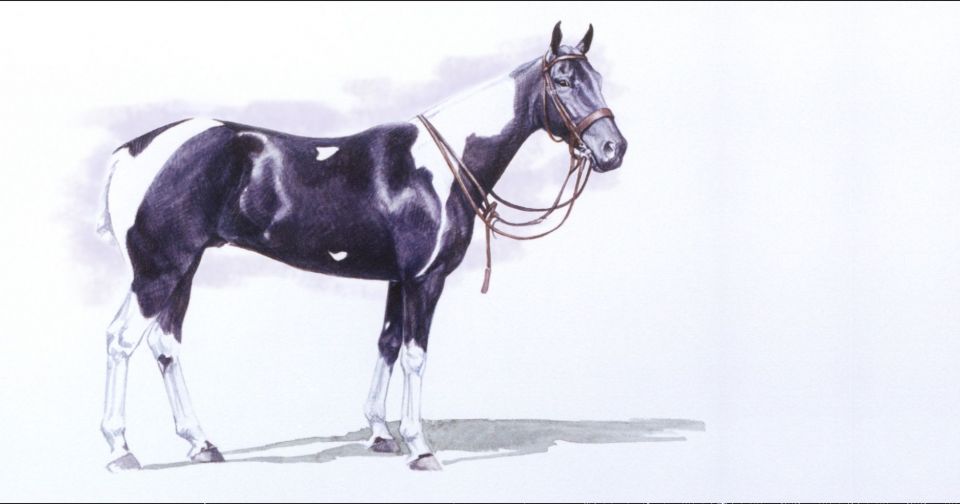Horses to Remember
Below you can search inductees by name, in alphabetical order, or by their year of induction, from 2000 to the present day, and read a short biography listing their accomplishments and contributions to the sport.

-
Alabama2003
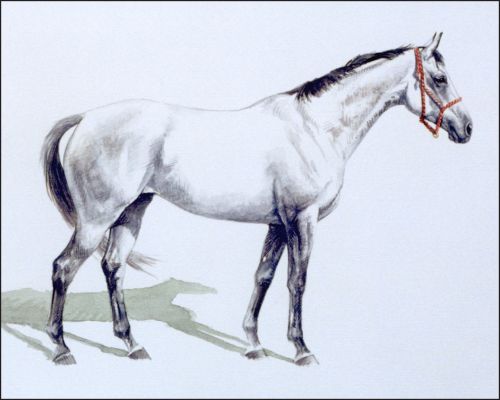 Inductee to Horses to Remember
Inductee to Horses to RememberAlabama
Elected 2003Alabama, a gray gelding owned by Steve Gose and played by Joe Barry, won the Hartman Award for Best Playing Pony in the U.S. Open in 1977 and ’79, the first horse to repeat. “He’s just a freak of nature,” Harold ‘Chico’ Barry once said. “I knew in a week or two I had a winner. He had the conformation and the right disposition and he thinks right. We gave him a winter of ranch work in Texas and then put him right into polo.” Alabama was known for being very fast, having a beautiful mouth, and being so comfortable to ride that it was like “riding air.”
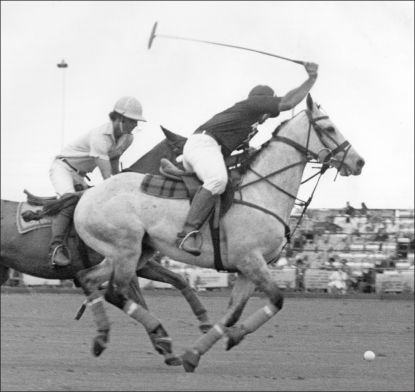
Foaled in April 1971, Alabama raced under the name Ask the Victory before being purchased as a 4-year old by Harold Barry. Alabama’s groom, Suzy Beeman, recalled Alabama’s first official polo game at San Antonio Park. “He’d never been away from home and had only played in practice games on the ranch. He really flipped out at the first sight of the kites flying and all the activity at the nearby riding academy, but he played fine... His mouth is beautiful. And even though he’s a big mover, he’s so smooth and comfortable to ride that you can feel it… he can really fly!”
Winning the Hartman trophy was only the beginning of an outstanding career. Joe Barry commented on the horse’s performance in a Michelob World Cup by saying, “It was the first time I had asked him for more than one period of polo in a game, but when it comes to that kind of polo you go with the best you’ve got. He came through for me. I played him in the fourth and then came back on him in the overtime period. If there was going to be a chance for a penalty shot I wanted to be on him.” That is the kind of confidence Alabama inspired.
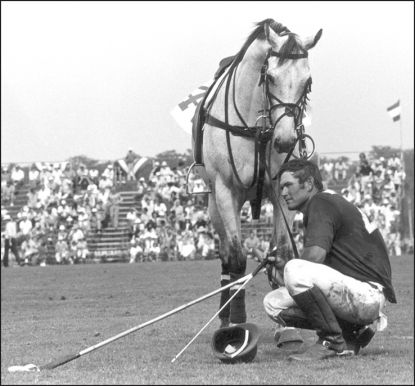
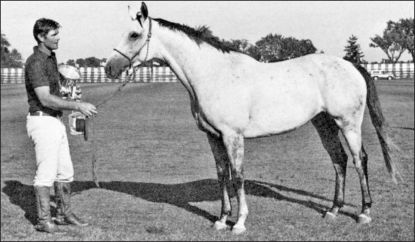
Watercolor portrait of Alabama (above left) by artist, Melinda Brewer; www.poloart.ca
-
Badger2000
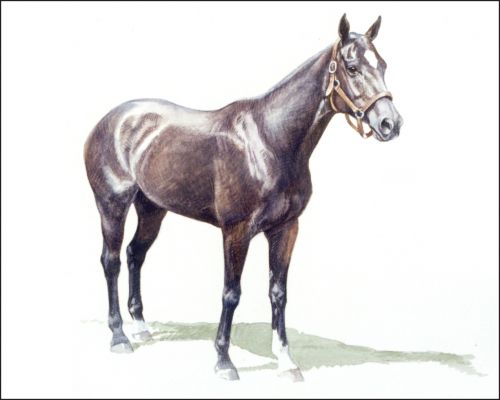 Inductee to Horses to Remember
Inductee to Horses to RememberBadger
Elected 2000Badger was Cecil Smith’s great “war horse.” A big brown gelding, Badger carried the famed Texan 10-goaler for two chukkers in every close game Smith played from 1950 through 1961. Fellow 10-goaler Bob Skene stated that Cecil Smith was really worth 12 goals when he rode Badger. In later years, Badger was played by Cecil’s son, Charles Smith (also inducted into the Hall of Fame, in 2004). As durable as he was talented, Badger played polo until he was 20 years old.
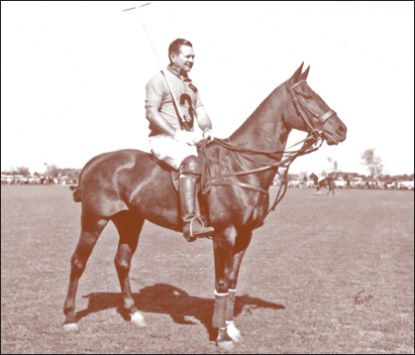
Cecil Smith on Badger
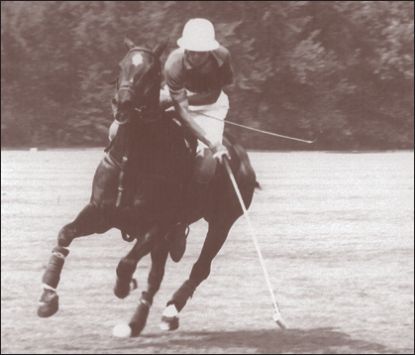
Charles Smith on Badger, Oakbrook 1961
Watercolor portrait of Badger (above left) by artist, Melinda Brewer; www.poloart.ca
-
Beetlejuice2014
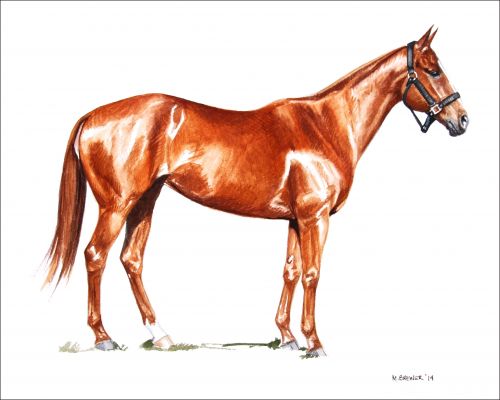 Inductee to Horses to Remember
Inductee to Horses to RememberBeetlejuice
Elected 2014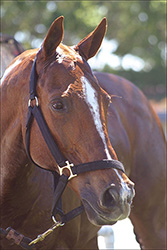 At just 14.3 hands, this small bundle of dynamite has not let her size stop here. She has won numerous awards including five 26-Goal best playing pony awards, one of which was the Hartman Award at the U.S. Open in 1996. In that game, Beetlejuice played almost three chukkers, helping Azzaro to score six goals on her alone. Mike has said that was the best game he ever played with her. Playing at the age of 18 in the 2006 U.S. Open, the petite polo veteran dazzled everyone with her speed and handiness.
At just 14.3 hands, this small bundle of dynamite has not let her size stop here. She has won numerous awards including five 26-Goal best playing pony awards, one of which was the Hartman Award at the U.S. Open in 1996. In that game, Beetlejuice played almost three chukkers, helping Azzaro to score six goals on her alone. Mike has said that was the best game he ever played with her. Playing at the age of 18 in the 2006 U.S. Open, the petite polo veteran dazzled everyone with her speed and handiness.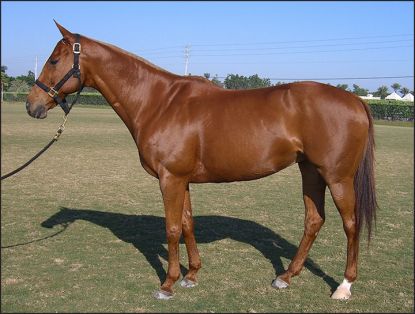
Watercolor portrait of Beetlejuice (above left) by artist, Melinda Brewer; www.poloart.ca
-
Belle of All2009
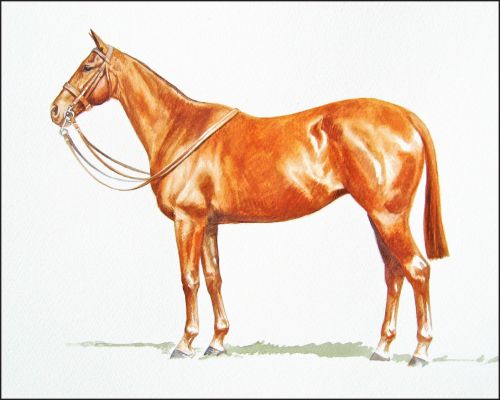 Inductee to Horses to Remember
Inductee to Horses to RememberBelle of All
Elected 2009In the hands of Louis Stoddard, Belle of All played brilliantly and with the heart of a lioness. At Hurlingham in 1921, the U.S. regained the Westchester Cup with Stoddard sensational on his beloved Belle of All. They played two grueling matches of seven chukkers, both of which the U.S. won. Belle of All played three periods in each, and was praised by the outstanding poloists of the time for her incredible speed, stamina and courage. In her day, Belle of All was referred to as “easily queen of thoroughbred polo ponies ever bred in America.”
Beautiful and “frightfully fast,” she was bred by Col. E. R. Bradley near Lexington, Kentucky, and was tempestuous from the first. She passed through seven owners in about as many months, before Mr. and Mrs. Louis Stoddard paid Fred Post a visit and the lady, captured by the Belle’s appearance, immediately purchased her as a gift for her husband, at that time at the height of his polo fame.
Belle of All played at Hurlingham in the Westchester Cup of 1921, and fresh from that success she won the Championship of the National Polo Pony Society show in 1921 and again in 1922. After her active polo days were over, she was retired to the stud of Harry Payne Whitney, leaving her legacy in the form of great offspring, most notably Capsheaf and Honu.
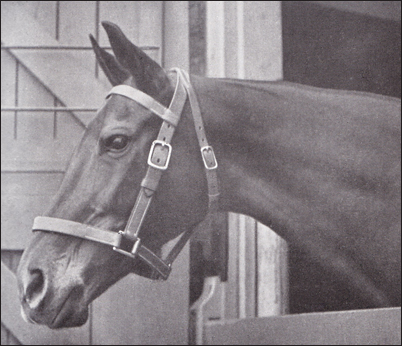
Watercolor portrait of Belle of All (above left) by artist, Melinda Brewer; www.poloart.ca
-
Bonnie J2007
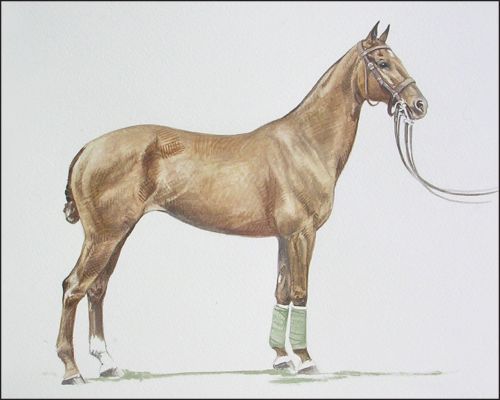 Inductee to Horses to Remember
Inductee to Horses to RememberBonnie J
Elected 2007Bonnie J was a dun mare who 10-goaler Cecil Smith recalled as the best pony he ever owned. At first, she was just a five-year-old ranch horse from Texas, comfortable around cattle but with no interest at all in sticks, balls or learning how to play polo. But when she took the field with other horses, something clicked, and she became a legendary pony of the 1930s. Smith wrote, “She had the softest mouth you could want... I just touched the rein to put her where I wanted her. If the ball bounced off a divot, at the last second, she could flip over to where I could hit it.”
One of her signature moves was to stop and whirl in an instant. On one occasion, a following horse and rider could neither believe what they were seeing nor stop in time to prevent a collision that broke Smith’s collarbone.
When the Old Westbury team was gathering horses for the 1937 U.S. Open, Sonny Whitney made Smith an offer. “You can’t afford to keep that horse,” he said. “I’ll buy her and you can play her in the Open.” Later, after Old Westbury emerged victorious, Whitney gave the mare back to Smith.
Smith played Bonnie J in England in 1936 and 1938, and in a ’38 match she was judged the best playing pony. A British sports writer singled her out as, “uncommonly fast... perhaps the best in the lot... gallant and amazingly quick off the mark.”
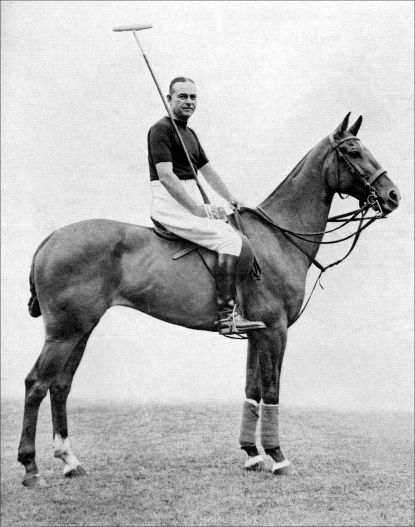
Charles Wrightsman on Bonnie J, England 1938
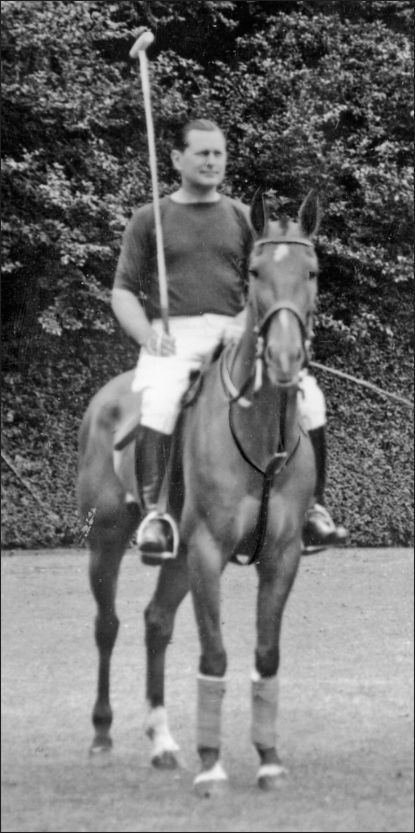
Cecil Smith on Bonnie J, England 1938
Watercolor portrait of Bonnie J (above left) by artist, Melinda Brewer; www.poloart.ca
-
Brown Fern2012
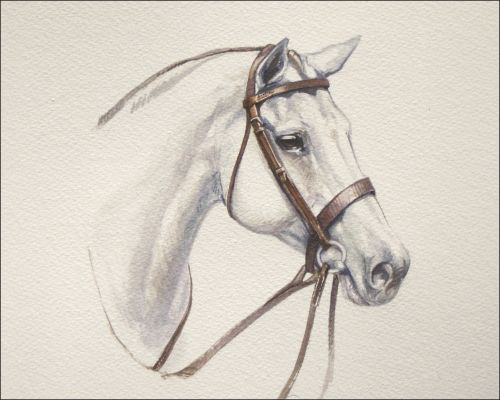 Inductee to Horses to Remember
Inductee to Horses to RememberBrown Fern
Elected 2012An American-bred, thoroughbred, gray gelding, Brown Fern was originally bred to race by Isabel Dodge Sloane, owner of the Brookmeade Stable, and was later owned by Michael Phipps. As per the great horseman Tommy Glynn, “In his new role as a polo performer, Brown Fern became a sensation.” After only two seasons in polo, Brown Fern played two excellent periods a game for Stewart Iglehart on the winning U.S. team of the 1936 International matches with Great Britain. He played in the 1937 U.S. Open Final for Phipps, and again for Phipps in the 1939 Internationals.
Brown Fern’s performance was recounted in many publications, and it was the consensus of the experts that “Brown Fern was not only the best pony in the winning team but the best brought on the field by either side.” Further it was said, “He has become a magnificent polo pony, and his services were of untold value... Brown Fern was always doing his bit at the crucial moment... and it is not too much to say that in some respects his performance was sensational. We have particularly in mind his wonderful effort in the last minute of the first game, when he was up against a fresh pony ridden by Mr. Balding. Although this was the close of Brown Fern’s second chukker in the match, he beat the other in the gallop and turn for the ball... Altogether, he is a pony which America can be proud to have bred.”
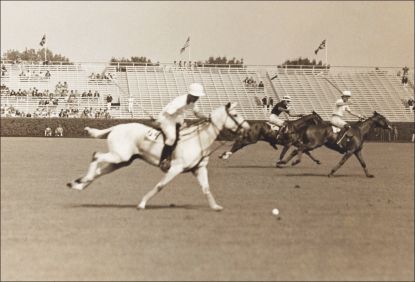
Brown Fern with Michael Phipps
Watercolor portrait of Brown Fern (above left) by artist, Melinda Brewer; www.poloart.ca
-
Burrito2007
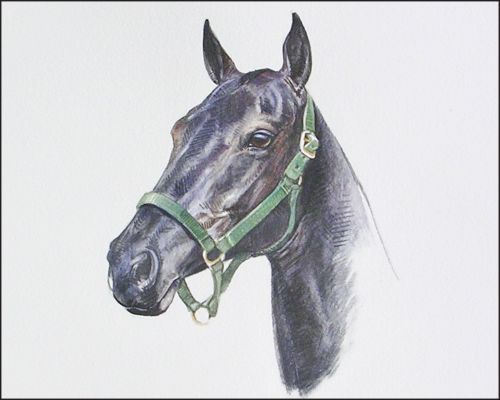 Inductee to Horses to Remember
Inductee to Horses to RememberBurrito
Elected 2007Burrito was a handsome, “blindingly fast” dark bay thoroughbred gelding bred at John T. Oxley’s Oxley Polo Stables by breeder/trainer Joe Casey. Originally named Ike’s Chivo, he was by Chivo out of Real Glory, both bloodlines reaching back to racing greats. Burrito’s handlers stopped counting his numerous Best Playing Pony awards, but do recall those won in the 1978 America Cup, 1978 Continental Cup, and the 1981 USPA Gold Cup. All who knew him said that his speed, handiness and game sense were above reproach.
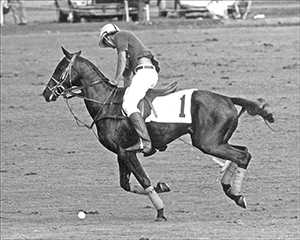 Burrito started his first season in polo with Memo Gracida, then at six goals, and playing for John Oxley. Burrito was then played by polo legends Gonzalo Pieres and Ernesto Trotz in the 1980’s, each crediting this remarkable horse with helping them rise to their 10-goal handicap and naming him as a favorite. Considering all of the great ponies these two have played in tournament victories all over the world, it is noteworthy that both singled out Burrito. Gonzalo Pieres put Burrito on an even plane with Levicu, another of our “Horses to Remember.” Ernesto Trotz played Burrito for three years, and once scored six goals from the field in a single chukker.
Burrito started his first season in polo with Memo Gracida, then at six goals, and playing for John Oxley. Burrito was then played by polo legends Gonzalo Pieres and Ernesto Trotz in the 1980’s, each crediting this remarkable horse with helping them rise to their 10-goal handicap and naming him as a favorite. Considering all of the great ponies these two have played in tournament victories all over the world, it is noteworthy that both singled out Burrito. Gonzalo Pieres put Burrito on an even plane with Levicu, another of our “Horses to Remember.” Ernesto Trotz played Burrito for three years, and once scored six goals from the field in a single chukker.Memo Gracida had this to say about Burrito in a 1986 interview:
“You always like to believe your own ponies are the best, but the horse I most respect belongs to somebody else. The horse is Burrito… I saw him develop into the complete polo machine, and he deserves full recognition as one of the top ten polo ponies in the world… What makes him so different is his fitness and stamina, his endurance. His speed is tremendous. I don’t think we’ll ever see a horse like that again on a polo ground or find another to emulate his performance.”
David Wigdahl, who owned Burrito for two years and later sold him back to Oxley, noted, “When the chips are down, there’s no better horse than Burrito, the ‘Secretariat of Polo’.”
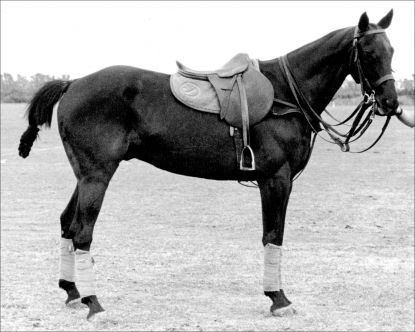
Watercolor portrait of Burrito (above left) by artist, Melinda Brewer; www.poloart.ca
-
Califa2016
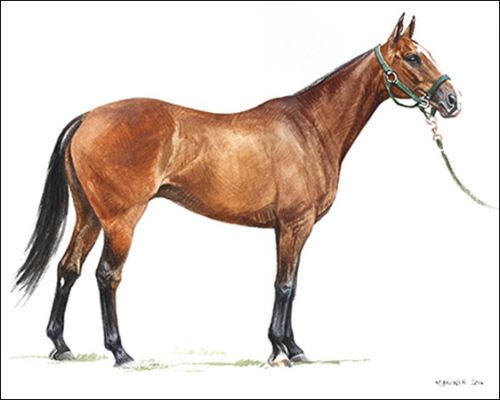 Inductee to Horses to Remember
Inductee to Horses to RememberCalifa
Elected 2016Bred in Argentina and foaled in 1996 as part of the famed Pieres breeding program, the famous bay gelding, Califa, is owned by Peter Brant of White Birch Farms and has served as a durable war horse for Mariano Aguerre in many memorable contests. Gathering numerous honors along his way, Califa ultimately earned the Hartman Award for Best Playing Pony after his gritty and intense play in two chukkers under Aguerre at the 2004 U.S. Open Championship.
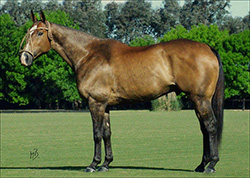
Aguerre called on Califa again for the 2005 high-goal season and the gutsy gelding didn’t disappoint as they fought together through crucial games helping the team sweep all three 26-goal tournament victories. A horse of incredible power and stamina, Califa was recognized as the 2006 Horse of the Year, was a member of 2006 APHA U.S. Open best string, 2003 BPP of the Butler Handicap, and the 2004 BPP of the Mercedes Benz Cup. (image above courtesy of Marcelo Bianchi)
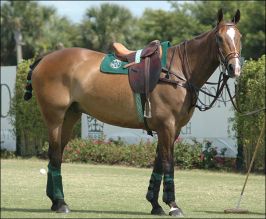 Having proven himself as a polo superstar and of impeccable breeding (Califa’s dam, La Luna, was a famous polo mare out of Top Secret and Gaucha), the owners realized that cloning Califa would be a way to try to perpetuate his legacy that, being a gelding, he would not otherwise be able to fulfill. His first clone arrived on April 22, 2010, and is now being successfully played in Argentina. (photo courtesy of Melinda Brewer)
Having proven himself as a polo superstar and of impeccable breeding (Califa’s dam, La Luna, was a famous polo mare out of Top Secret and Gaucha), the owners realized that cloning Califa would be a way to try to perpetuate his legacy that, being a gelding, he would not otherwise be able to fulfill. His first clone arrived on April 22, 2010, and is now being successfully played in Argentina. (photo courtesy of Melinda Brewer)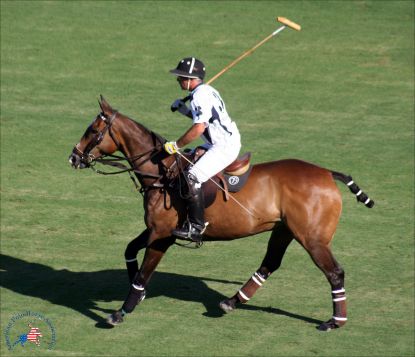
Califa with Mariano Aguerre up; 2009 Argentine Open; (photo courtesy of American Polo Horse Association)
Watercolor portrait of Califa (above left) by artist, Melinda Brewer; www.poloart.ca
-
Cat A Joy2000
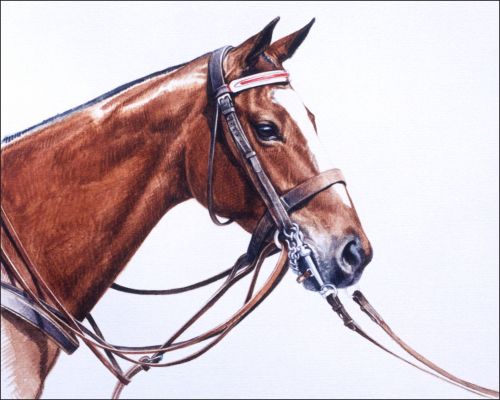 Inductee to Horses to Remember
Inductee to Horses to RememberCat A Joy
Elected 2000Cat A Joy was one of the Oxley Stable’s finest, a bay mare bred and played by John T. Oxley and trained by Joe Casey. She was played by Gonzalo Pieres in the 1980 Gold Cup finals and was awarded Best Playing Pony in the last game, an award she had received many times previously. Both Oxley and Pieres said she was the finest horse they ever played.
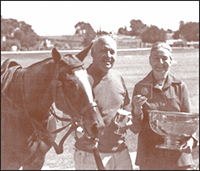 In her day, she could outrun anything on the field. According to John Oxley, “She had speed, and handled with a mouth as light as a feather.” Pieres was the only other player Oxley would allow to play the mare. After the 1980 Gold Cup final, former 9-goaler Daniel Gonzalez said he had never seen a performance like hers from any other horse. Cat A Joy played seven seasons in the Sunshine League and in many USPA national tournaments.
In her day, she could outrun anything on the field. According to John Oxley, “She had speed, and handled with a mouth as light as a feather.” Pieres was the only other player Oxley would allow to play the mare. After the 1980 Gold Cup final, former 9-goaler Daniel Gonzalez said he had never seen a performance like hers from any other horse. Cat A Joy played seven seasons in the Sunshine League and in many USPA national tournaments.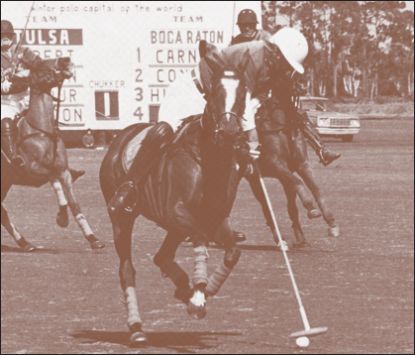
Her numerous best playing pony awards included: Best Playing Pony award in the National Intercircuit tournament in 1976; Best Playing Pony award in the USPA America Cup tournament in 1978 and 1979; Best Playing Pony Award in the USPA Gold Cup tournament in 1980. At the time of Cat A Joy’s induction into Horses to Remember, John Clark said, “She was the best and deserves to be with the best.”
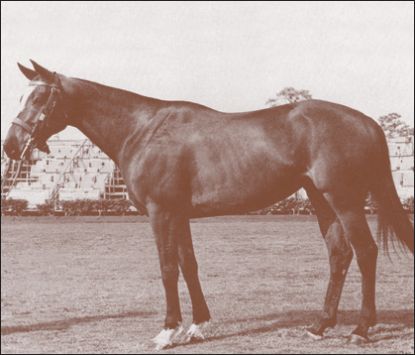
Cat A Joy at Royal Palm Polo Club
Watercolor portrait of Cat A Joy (above left) by artist, Melinda Brewer; www.poloart.ca
-
Chica Boom2000
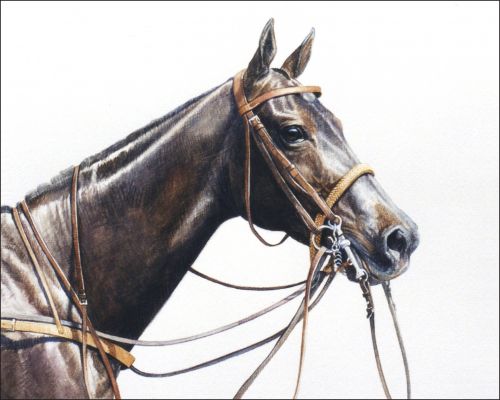 Inductee to Horses to Remember
Inductee to Horses to RememberChica Boom
Elected 2000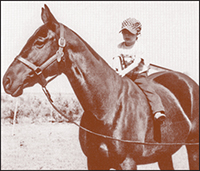 Chica Boom was a mare bred and trained by Bart and Nena Evans on their ranch near Midland, Texas. The dark bay pony, “the color of blackstrap molasses,” was a two-time winner of the Hartman Trophy, in 1982 and ‘84, and was the best playing pony in the 1986 International Gold Cup. Her record included play in the 1981 Sunshine League, the 1981 and ‘82 Gold Cups, the 1981 Cartier International Open, the 1982 World Cup, and the 1981, ‘82 and ’84 U.S. Open Championships.
Chica Boom was a mare bred and trained by Bart and Nena Evans on their ranch near Midland, Texas. The dark bay pony, “the color of blackstrap molasses,” was a two-time winner of the Hartman Trophy, in 1982 and ‘84, and was the best playing pony in the 1986 International Gold Cup. Her record included play in the 1981 Sunshine League, the 1981 and ‘82 Gold Cups, the 1981 Cartier International Open, the 1982 World Cup, and the 1981, ‘82 and ’84 U.S. Open Championships.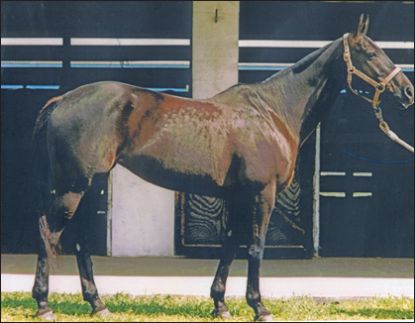
Chica Boom began her polo career at age three, and by age six had graduated to the high-goal tournament ranks. When asked, owner Bart Evans could not name his favorite moment with Chica Boom. “There were too many to count. Every time I played her it was memorable.”
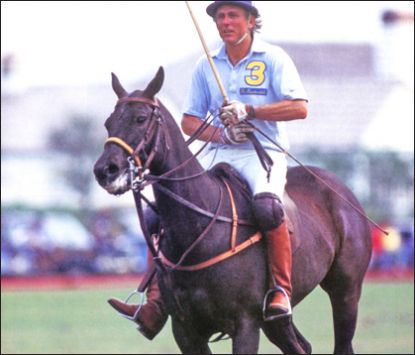
Working cattle at the ranch, Chica Boom became quicker on her feet than the wiliest cow. On trips to Midland Polo Club, she learned to handle bumps and ride-offs, and developed a sense of where the action would flow. And if the action stopped, her front feet remained in constant motion, anticipating the change in the direction of play. In an interview, Nena Evans noted, “When she moved, you’d think chica-boom, chica-boom, chica-boom, boom, boom -- the beat of a song that was popular that year. So her name was a natural.”
At the height of her polo career, Bart Evans said, “She’s so quick and easy; you wonder sometimes if she’s flesh and blood. Whatever you ask of her, she does without hesitation. Chica Boom has never said no.”
Watercolor portrait of Chica Boom (above left) by artist, Melinda Brewer; www.poloart.ca
-
Chicken2017
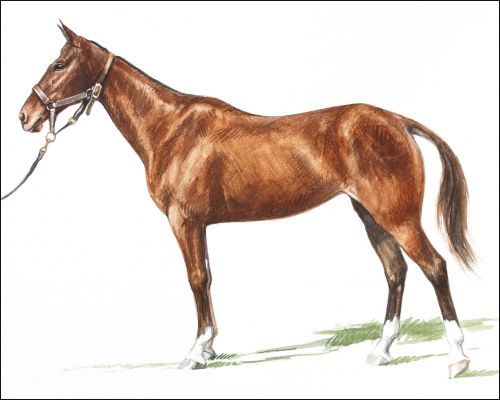 Inductee to Horses to Remember
Inductee to Horses to RememberChicken
Elected 2017A bay mare bred in Virginia of unknown parentage, Chicken was discovered in the Remount Depot at Front Royal by Col. Walter C. Short. She had a long career as a polo mount in many hard-fought campaigns of Army polo for Major W.W. Erwin and Capt. Peter Rodes.
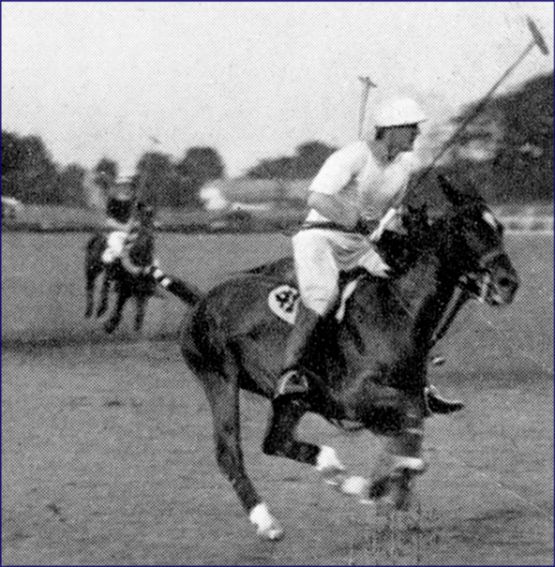
Mr. Stevenson on Chicken after the ball; P&A photo from October 1927 POLO magazine
Then in 1927, proven as a true “war horse,” she again earned a place playing for her country, in the International series under Hall of Famer Malcolm Stevenson. In international competition, Chicken never played on a losing side. Though “aged,” she played with heart, tenacity and courage, and in 1927 was selected from among a huge field of superstar talent for the coveted Prince Friarstown Cup, given to the best mare playing in the tournament suitable to produce a polo pony, the highest award of that era. Polo Magazine noted, “She knows what it is to be brought out and asked to play when, because of soreness, the task is none too easy, but her gallant spirit carried her through, and her history concerns itself with victory upon victory."
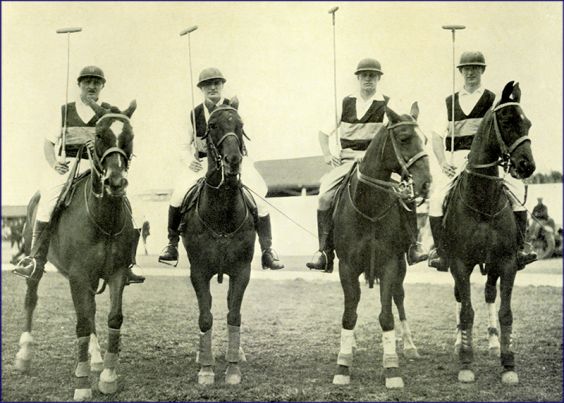
Capt. R.E. Craig on Chicken at left, Fort Bliss Polo Team, 1923 Pacific Circuit Cup Winners; photo from 1924 USPA Yearbook
Watercolor portrait of Chicken (above left) by artist, Melinda Brewer; www.poloart.ca
-
Chips Royal2012
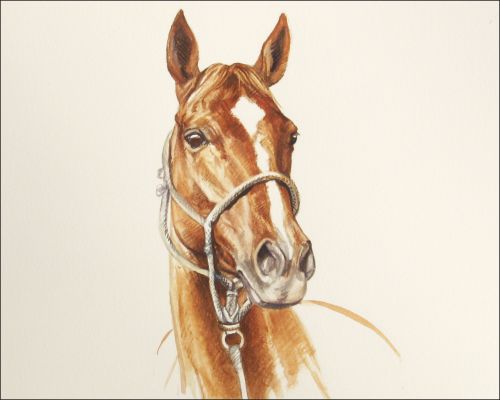 Inductee to Horses to Remember
Inductee to Horses to RememberChips Royal
Elected 2012Chips Royal was the winner of the 1973 Hartman Award in the U.S. Open. Chips was owned by Robert D. “Bob” Beveridge, a 7-goal amateur who was playing for Oak Brook in the final. Beveridge said, “Chips was the only green one I ever had who just knew everything. She was a complete natural. She was handy and smooth and fast and acted like she just LOVED to play. She had a wonderful temperament, too.”
Not many horses played by nonprofessionals have been honored as Best Playing Pony in the U.S. Open. Cecil Smith was judging BBP at the Open in 1973, and his son Charles was also playing on the Oak Brook team. One of Charles’ horses was poised to win the award until Cecil saw the last run Chips Royal made for Bob Beveridge. Cecil said, “I just had to give it to her.”
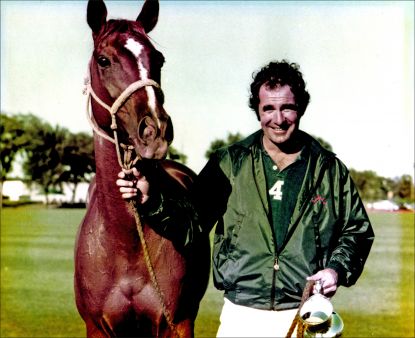
Bob Beveridge with Chips Royal
What set Chips Royal apart was that she could read a horse coming to her, make her calculations, and move a horse, even one half again as big as she was, out of the way with pure smarts. It was said she could outrun everything and keep on doing it. Warren Gourley, who worked for Beveridge, said, “I remember her running belly down and then sticking her tail in the ground and just waiting—with her front feet patting the ground—for the next signal.” And he adds, “Chips was such a lady.”
Watercolor portrait of Chips Royal (above left) by artist, Melinda Brewer; www.poloart.ca
-
Conover2019
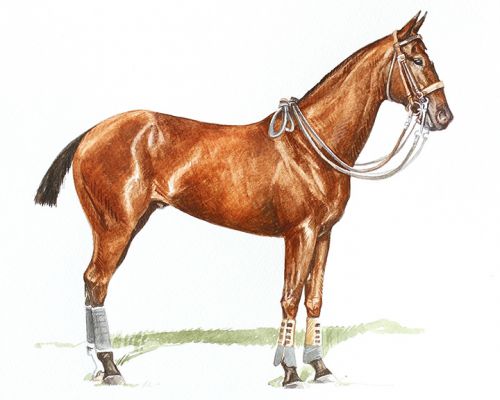 Inductee to Horses to Remember
Inductee to Horses to RememberConover
Elected 2019Conover was part of the enviable string of Harry Payne Whitney. Played by Whitney as well as Monty Waterbury, he was a star of the Internationals in 1909, 1911, 1913 and 1914 as an aged horse but still a mainstay for the legendary “Big Four” who dominated International Polo in those years.
The tough Texan-bred bay gelding was foaled sometime between 1892 and 1895 if the stories reporting his age are correct. Although written accounts differed slightly from year to year, it is still clear that he played remarkably as an aged pony. Conover was lauded for his speed and brilliant performances over a number of years of grueling International matches both here and overseas. It was said that he had “brought fame to the Texas cowpony,” was described as “a hero” and “one of the best of the Whitney string.” He proved himself to be a mount with an indomitable spirit - a gallant, game war horse for two Hall of Famers who made up half of the hardest-riding and most competitive polo teams of the era, The Big Four.
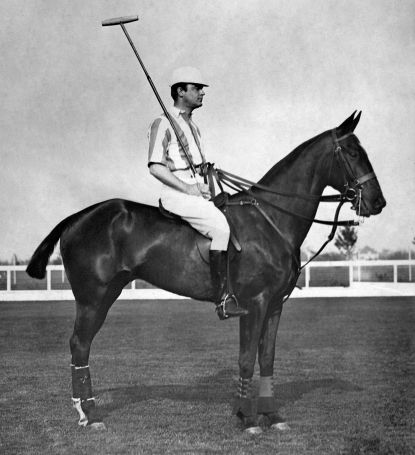
Conover with J. Monty Waterbury astride, circa 1914
After a long and illustrious career, Conover was retired and relied upon as a trusty mount for the Whitney children.
Watercolor portrait of Conover (above left) by artist, Melinda Brewer; www.poloart.ca
-
Cottontail2008
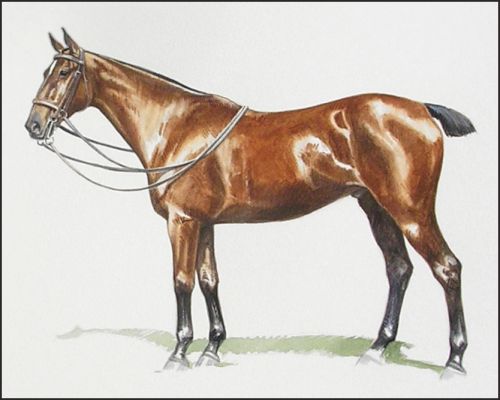 Inductee to Horses to Remember
Inductee to Horses to RememberCottontail
Elected 2008One of the great American ponies of the “Big Four” era was Harry Payne Whitney’s Cottontail, a grand bay gelding “possessed of great power and extreme speed.” By one account, “He had, perhaps, a rather plain head, but in some of those plain heads is infinite horse sense, and Cottontail was as wise as any pony could be.” He was played by Whitney in England in 1909 and at Meadowbrook in 1911 and 1913. In each of these hard-fought contests, he was Mr. Whitney’s mainstay and never faltered – not once did the American team lose a match.
Newell Bent, in his book American Polo (1929), said, “Any story of California polo is incomplete without a tribute to California pony breeders and the California polo pony, for ever since the day when Mr. Laurence McCreery sold to Mr. Whitney the wonderful Cottontail, the pony that played an outstanding game in the international matches of 1909, 1911, and 1913, the California polo pony has been among the world’s best.”
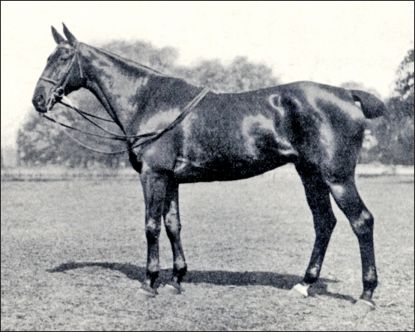
Whitney’s string was said to be superb, and Cottontail was its star. He had power, great speed, and was conditioned to perfection by Whitney’s trainer, Larry Fitzpatrick. In 1927, Polo magazine referred to him as “the best polo pony in creation.”
A famed Herbert Haseltine bronze, cast in 1909 and known as “The Big Four,” depicts the Meadowbrook team and its mounts. Captain Harry Payne Whitney is on Cottontail, forever.
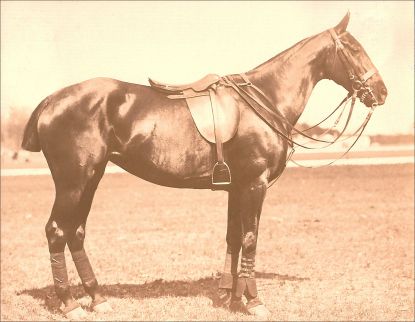
Cottontail, 1911
Watercolor portrait of Cottontail (above left) by artist, Melinda Brewer; www.poloart.ca
-
Delta Dawn2003
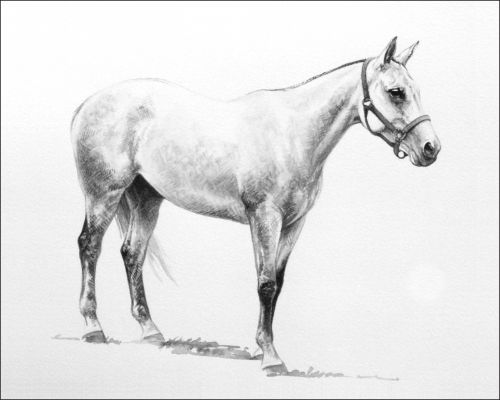 Inductee to Horses to Remember
Inductee to Horses to RememberDelta Dawn
Elected 2003Delta Dawn was a gray thoroughbred mare trained by Cecil Smith, owned by Norman Brinker, and played by Roy Barry. She was honored with the Hartman Award as Best Playing Pony in the 1974 U.S. Open. Brinker recalled, “She had wonderful attitude, determination and speed. When Roy got on her, I knew good things were going to happen.”
Norman Brinker bought Delta Dawn from Cecil Smith as a 4-year-old in 1973. Smith noted, “She was just a ranch horse I bought in the Hill Country, but she showed natural ability right from the start. You just knew she was going to be a great one.”
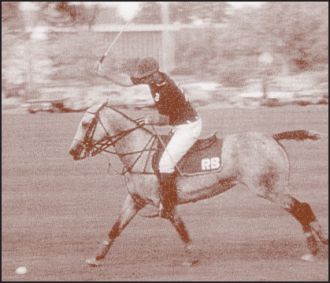 She was trained by Cecil Smith and first played under Charles Smith. Her new rider, Roy Barry, renamed her after a song that was then popular. She was generally sent out in a double bridle, and played one period toward the end of the game.
She was trained by Cecil Smith and first played under Charles Smith. Her new rider, Roy Barry, renamed her after a song that was then popular. She was generally sent out in a double bridle, and played one period toward the end of the game.In 1978, Delta Dawn had surgery on both knees, and doctors said she would never play again. But, as one writer noted, when the doctors looked at her knees, they forgot to consider her spirit. Delta Dawn indeed played again, including an appearance in the 1980 U.S. Open Championship match, before retiring from polo at the age of 12.
After her playing days were over, Delta Dawn passed on her spirit through breeding. “She had some incredible colts,” Brinker said. Delta’s manners, however, left something to be desired. She would bite and kick at feeding time and was described as “crotchety” because she didn’t like to be handled. Being a top pony, she tended to have a tough personality.
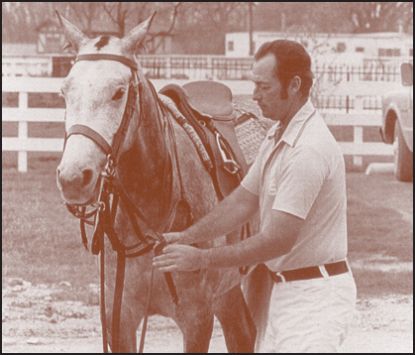
Roy Barry snd Delta Dawn
Watercolor portrait of Delta Dawn (above left) by artist, Melinda Brewer; www.poloart.ca
-
Electric Charge2005
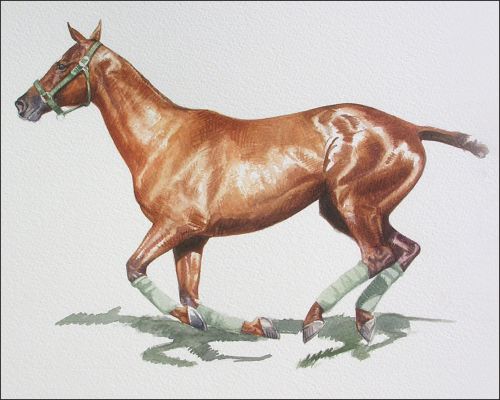 Inductee to Horses to Remember
Inductee to Horses to RememberElectric Charge
Elected 2005Electric Charge was a dark chestnut, thoroughbred mare and the winner of the Hartman Trophy in 1981. She also played and won the Cartier Handicap and played in the Camacho Cup in 1981. She was owned at that time by Seth Herndon who rode Electric Charge in numerous other high goal tournaments for five years, including two chukkers each in the final and semi-finals of the U.S. Open.
Electric Charge was bred in Oklahoma by John Durham and trained by Henry Burnell of Tulsa who sold her to Ralph Lafferty, who then sold her to Gary Wooten. Seth Herndon bought her from Wooten in 1978. All agreed she had endless stamina. Gary Wooten perhaps said it best: “Day in and day out she played like a machine. Her stamina was incredible, it was like there was no bottom to her. And she had a great heart; she’d go anywhere, do anything you’d ask.”
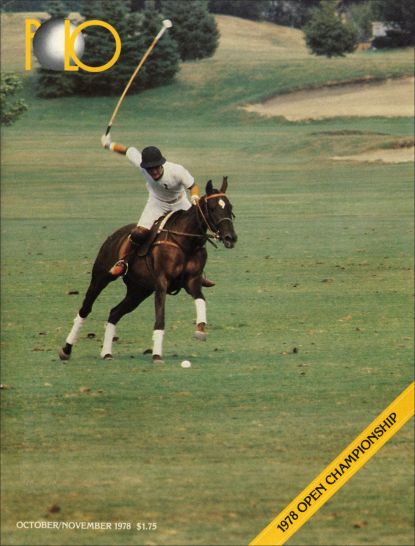
Seth Herndon talked about another dimension of her greatness, her speed: “She was truly a high goal mare. She handled wonderfully at speed and had speed to burn. She did not like slow or choppy polo and let you know it.”
And to complete the picture, she handled like a dream. “When I played in and won the finals of the Cartier Handicap,” Herndon said, “I’d injured my hand, and I remember breathing a sigh of relief each time I rode Electric Charge, because she was the easiest of my horses to ride.”
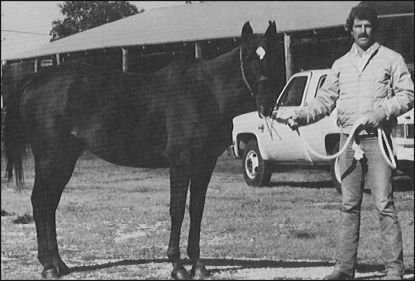
Watercolor portrait of Electric Charge (above left) by artist, Melinda Brewer; www.poloart.ca
-
Ever Ready2013
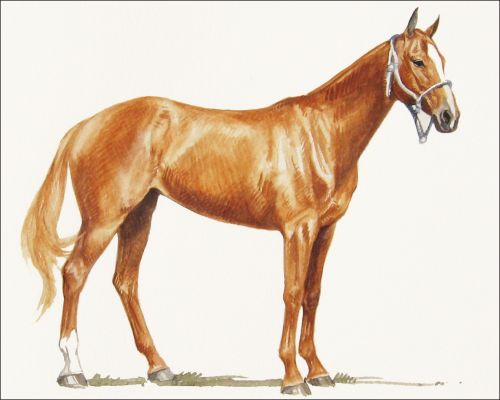 Inductee to Horses to Remember
Inductee to Horses to RememberEver Ready
Elected 2013A chestnut mare, trained and played by Ray Harrington (Hall of Fame 1993), Ever Ready was Ray’s “war horse” on whom he depended throughout his extraordinary four consecutive wins in the U.S. Open, 1966-1969. She was awarded the Hartman Award for Best Playing pony of the Open in 1969, and also that year played with distinction in Argentina in the 1969 Cup of the Americas at Palermo.
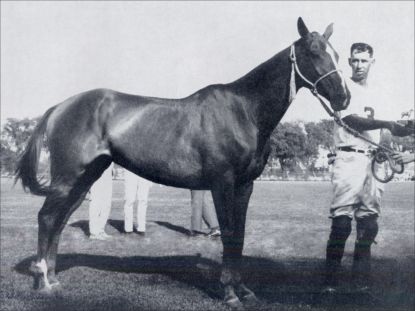
Watercolor portrait of Ever Ready (above left) by artist, Melinda Brewer; www.poloart.ca
-
Fairy Story2013
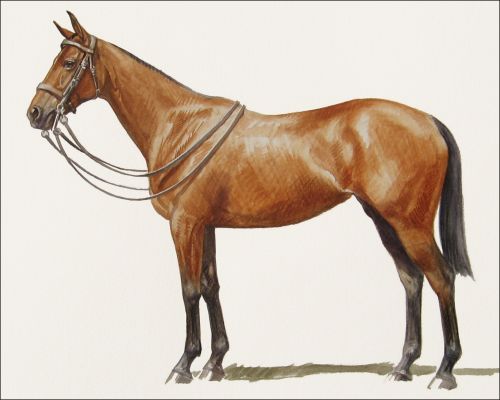 Inductee to Horses to Remember
Inductee to Horses to RememberFairy Story
Elected 2013A celebrated mare bred in England, Fairy Story first came to the U.S. in 1923 when the Hurlingham team played in the U.S. Open. Originally owned and played by Earle W. Hopping, she was bought by the Marquis Cholmondeley who in turn sold her to Lord Wimborne. In 1924, Fairy Story returned to the U.S. and was purchased at auction by Stephen “Laddie” Sanford. She was one of the top polo ponies in the 1920s, dubbed "the queen of all ponies," sweeping an unprecedented number of the major awards, including the Polo Pony championship in 1924, ’25 and ’33, retiring the cup at the age of 17 with her third win. After her final appearance in the show ring, one of the grooms said, “That mare is as handy as a pocket on a shirt.”
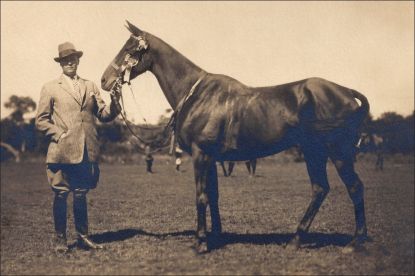
Laddie Sanford and Fairy Story
Watercolor portrait of Fairy Story (above left) by artist, Melinda Brewer; www.poloart.ca
-
Fuss Budget2014
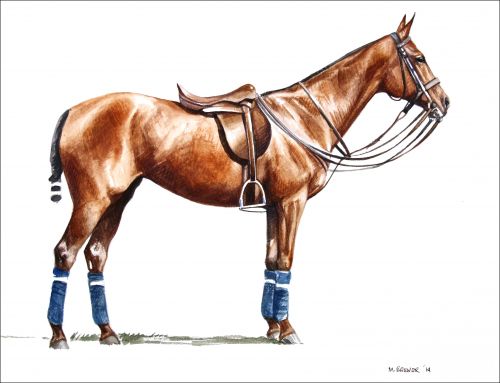 Inductee to Horses to Remember
Inductee to Horses to RememberFuss Budget
Elected 2014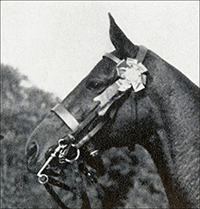 A Kentucky-bred thoroughbred mare foaled in 1928, Fuss Budget won 12 races before starting her polo career. A half-sister to racing legend Twenty Grand, she had great speed. Trained for polo by Terence Preece, Fuss Budget played with distinction in the most hotly contested matches of the era, most notably the U.S. Open Championship in 1937 and 1938, two chukkers in the final of the U.S. Open in 1939, ridden by Bob Skene, and three periods for Michael Phipps in 1940.
A Kentucky-bred thoroughbred mare foaled in 1928, Fuss Budget won 12 races before starting her polo career. A half-sister to racing legend Twenty Grand, she had great speed. Trained for polo by Terence Preece, Fuss Budget played with distinction in the most hotly contested matches of the era, most notably the U.S. Open Championship in 1937 and 1938, two chukkers in the final of the U.S. Open in 1939, ridden by Bob Skene, and three periods for Michael Phipps in 1940.Considered by owner C.V. Whitney as one of his greatest mounts, the speedy Fuss Budget earned many accolades, including the National Polo Pony Society’s Prince Friarstown Challenge Cup for best playing mare in 1937 and 1938. In 1939, Esquire magazine described her as “a devilishly clever bay horse,” and during her era, she was clearly “the First Lady of the Polo Realm.”
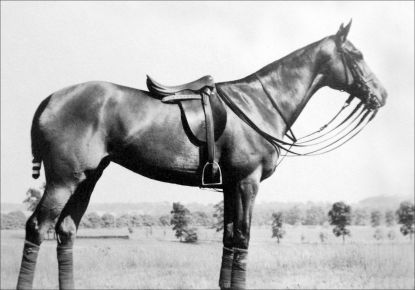
Watercolor portrait of Fuss Budget (above left) by artist, Melinda Brewer; www.poloart.ca
-
Gargantilla2020
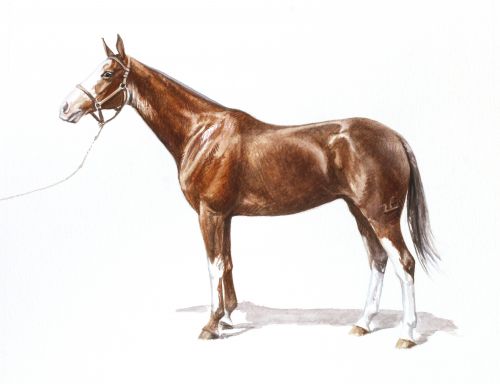 Inductee to Horses to Remember
Inductee to Horses to RememberGargantilla
Elected 2020The celebrated polo pony Gargantilla could not be confused with any other. A flashy piebald, white-throated mare, neither her appearance nor talent on the field could be ignored. Owned by Harry Payne Whitney, she was a favorite mount for his best friend Devereux Milburn with whom she is linked eternally, memorialized in numerous photos and at least two works of art for their unforgettable play together in the top matches of the era.
Foaled in 1914 in Argentina, Gargantilla first made her reputation as a star of the Argentine team, earning the title of best playing pony in 1921. The following year, after yet another victorious season, Gargantilla helped the Argentines win the Open Cup at Hurlingham in London followed by a victory of the US Open Championship of America in 1922 playing under John Miles and Lewis Lacey. At the conclusion of those matches the spectacular mare was promptly purchased by Harry Payne Whitney to add to his string of superior ponies. She immediately became a favorite mount for Whitney’s close friend Devereux Milburn, winning the most important matches in the U.S. in 1923, that feat capped off by winning the coveted Prince Friarstown Cup of the National Polo Pony Society. The celebrated duo went on to play together for many more years. Intriguing tributes to their special story are the portrayals of Milburn on Gargantilla by two of the most outstanding artists of the era, Sir Alfred Munnings and Franklin B. Voss.
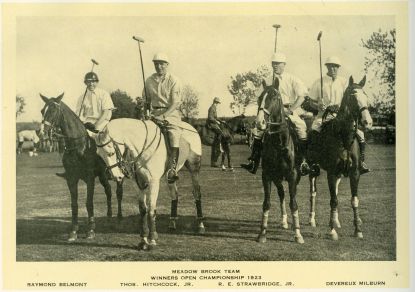
Gargantilla Milburn 1924 BB U.S. Open
-
Gay Boy2006
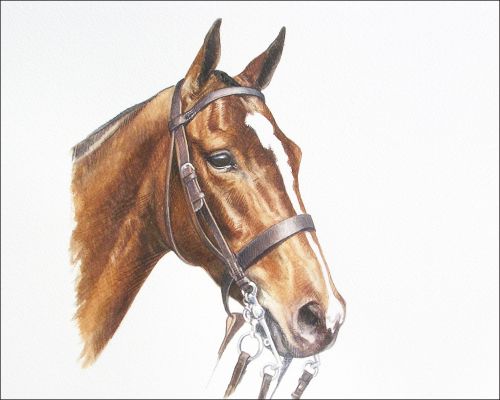 Inductee to Horses to Remember
Inductee to Horses to RememberGay Boy
Elected 2006Gay Boy, Texas rancher Will C. Gay’s gift to the game of polo, was a bay, half-thoroughbred gelding with “a white blaze down his wise and sensible head.” Considered the greatest polo mount of his day, Gay Boy was an incredible athlete with remarkable speed. He was best remembered for his sensational play in the 1927 International matches (U.S.A. vs. Great Britain): two chukkers in the first match and three in the second, ridden by polo Hall of Famer Malcolm Stevenson who considered this horse “supreme among ponies.”
Gay Boy worked as a cow pony for four years before being sold by Gay for $350. Gay Boy had the reputation of being one of the quickest horses on the get-away, a pony that could turn on a dime and scoot away like a quarter-horse.
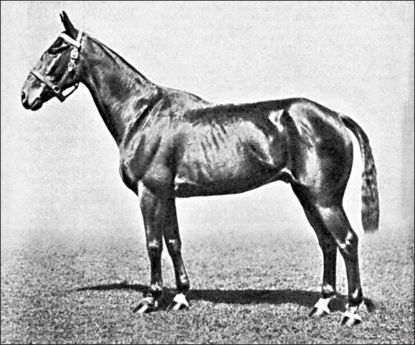
Newell Bent, author of American Polo (1929), noted, “For a half-bred pony, his willingness, strength and stamina were astonishing, for he was giving all he had the last minute as well as the first minutes of each and every period and was apparently impossible to tire. In addition, his speed was remarkable, for he was noticed time and time again to more than hold his own in long races for the ball against the pick of the English ponies.”
In addition to Malcolm Stevenson, Gay Boy was also played by Hall of Famers Robert Strawbridge Jr. and Tommy Hitchcock Jr. As part of Averell Harriman’s formidable string, Gay Boy was an outstanding pony in a string of outstanding ponies.
Gay Boy’s curious and tragic death in 1928 – crushed by a falling airplane while standing in his stall at Meadow Brook – took a great figure from the game. When Harriman was asked the cost of the pony, he said, “You can’t place a value on something that was priceless.”
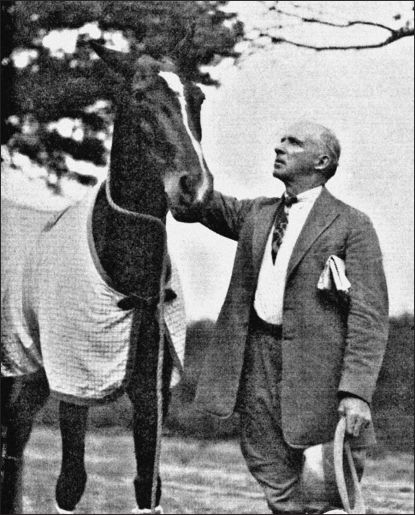
Gay Boy with J.A. Crawford, 1920s
Watercolor portrait of Gay Boy (above left) by artist, Melinda Brewer; www.poloart.ca
-
Jacobs2022
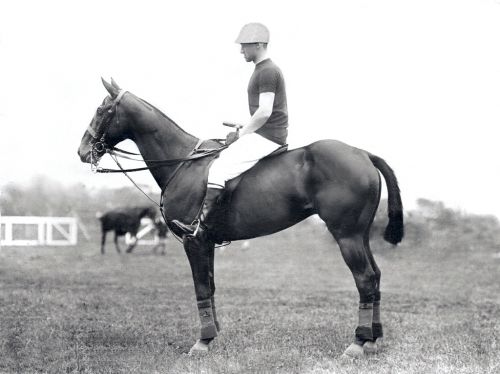 Inductee to Horses to Remember
Inductee to Horses to RememberJacobs
Elected 2022Jacobs (unknown breeding, Texas-bred) - Jacobs’ career spanned ten years playing in all the top tournaments of his era including the famed international matches of 1913 and 1914. A venerable pony who broke polo tradition in its time, he was one of the first bigger ponies that defined the approaching “modern” era of polo. Breaking the archaic height rule of 14 hands, 2 inches, Jacobs was a bay gelding who, standing at the unheard-of height of 15 h, 3 inches, was big, rawboned, and rangy, yet incredibly speedy and powerful. Bringing fame and notoriety to the Texas cowpony, Jacobs was raised by J.C. Jacobs of San Antonio, before being sold to Harry Payne Whitney who scoured the world to look for the most competitive ponies to add to his formidable string. Whiney also made a habit of loaning his finest ponies to his best friend Dev Milburn to play. The duo of Milburn and Jacobs caught the frequent attention of the press and it was noted that Milburn’s best runs were on this mount. It is a well-known story that, along with a few other top horses, Jacobs was gifted by Whitney to Milburn as a wedding present in 1913, a fitting gesture to honor the extraordinary relationship of a man and horse
-
Jupiter2005
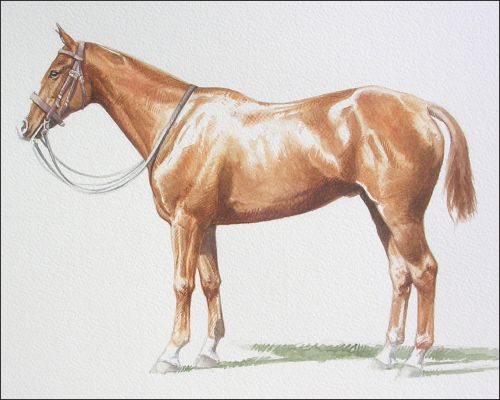 Inductee to Horses to Remember
Inductee to Horses to RememberJupiter
Elected 2005Played by Canadian-born, Argentine-raised 10-goaler Lewis Lacey in the 1928 Cup of the Americas, this chestnut pony impressed everyone with his skill and stamina over multiple chukkers. Jupiter was a quality pony, but with a difficult disposition, and it was only Lacey’s consummate horsemanship that brought out his best.
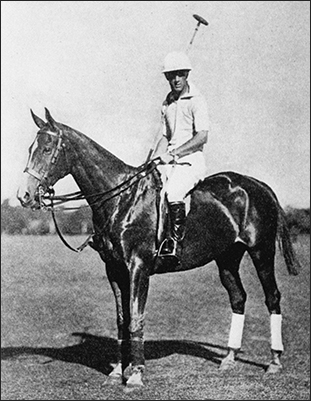
With Lacey, Jupiter played in the national polo championships of Argentina, Spain, England and the U.S.A., and in international games for Argentina against England and the U.S.A.
After Jupiter’s 1928 heroics, John Sanford offered $22,000 for the pony, an unprecedented sum for the time, buying the horse for his son, Laddie Sanford. The staggering purchase price (and Lacey’s skill in handling him) made Jupiter a famous horse. Cuthbert Bradley (1861-1943), an English painter of sporting dogs and horses, painted a watercolor portrait of Jupiter with Lacey up, and Jupiter is also shown with Lacey up in a photograph in American Polo (1929) by Newell Bent.
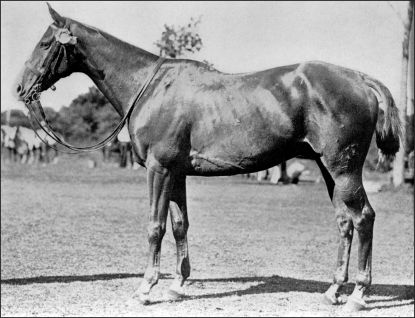
After his sale, Jupiter played under a number of players on Laddie Sanford’s Hurricanes team, and appeared in international games for the U.S.A. against England. After his retirement, he spent the rest of his days on the Sanford farm in Amsterdam, N.Y.
Watercolor portrait of Jupiter (above left) by artist, Melinda Brewer; www.poloart.ca
-
Kaliman2001
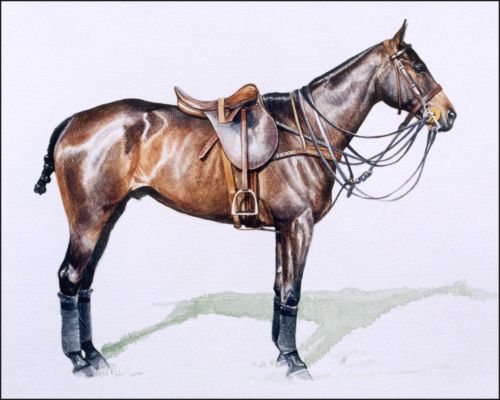 Inductee to Horses to Remember
Inductee to Horses to RememberKaliman
Elected 2001Kaliman carried Memo Gracida to victory many times and won a fair share of accolades along the way. The thoroughbred bay gelding from Wyoming twice won the Hartman Trophy for best playing pony in the U.S. Open, in 1987 and 1989, and was the star of Gracida’s string. “Every time I needed him, he always performed,” Gracida noted. “He gave me an outstanding chukker every time.”
When Memo Gracida bought the big thoroughbred from Bob Tate in Sheridan, Wyoming, he knew at first sight that the pony’s name had to be “Kalimán” – a name prompted by his resemblance to the Mexican comic book hero (“el hombre increible”) who was gifted with great physical strength and amazing mental powers. “He deserves and earns his name and ultimate respect,” Gracida noted. “Consistency-wise, he was beyond any other horse. I only wish I had more Kalimans.”
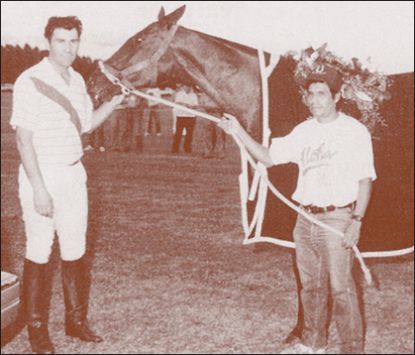
Memo Gracida with Kaliman, 1987
Kaliman often played two chukkers and had “lots of mileage” according to Gracida, who retired him at 12. “He was a very fluid horse. His biggest attributes were his balance and fluidity. He was not on legs; he was on wheels. He had tremendous acceleration for a horse that was sixteen hands.”
Bob Tate added: “He was mentally tough and could bump, or should I say ‘hit,’ like a middle linebacker. The harder you played him the quicker and more responsive he got. He was a champion among champions.”
Watercolor portrait of Kaliman (above left) by artist, Melinda Brewer; www.poloart.ca
-
Katrina2015
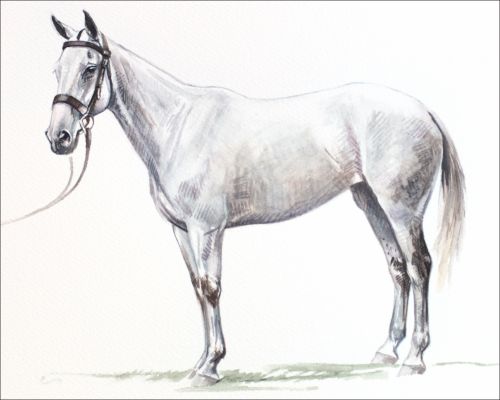 Inductee to Horses to Remember
Inductee to Horses to RememberKatrina
Elected 2015The great gray mare Katrina was bred and first played in Argentina by Charles N. “Bunny” Land. At the time of the trials for the 1930 Westchester Cup matches, she was owned by the Unites States Polo Association who lent her to the American team. Played by 10-goal legend and team captain Tommy Hitchcock, the powerful Katrina helped the U.S. to their victory over Great Britain.
At the conclusion of those matches, Hitchcock paid $10,000 to acquire this gifted mount. She went on to play with distinction for him in the 1933 East West matches, was played by Jimmy Mills in Hitchcock’s absence in the 1934 East West matches, and played gallantly for a total of 12 years and in 30 international contests.
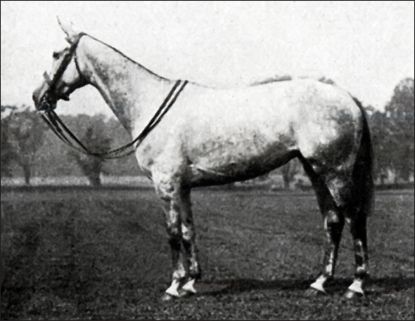
In 1930, Polo magazine noted (alluding to Hitchcock’s piebald gelding, Tobiana), “This year the American captain was mounted on another pony of unusual coloring. Against the browns, the bays, and the chestnuts on International Field, the big gray Katrina was there for all to see. And in addition to being ridden by Hitchcock, and being easy to pick out, she was one of the best playing ponies on the field. In the first match, she was ridden only for one period. In the second, she was played for two, including that blazing sixth in which the Americans, going great guns, once and for all established their superiority.”
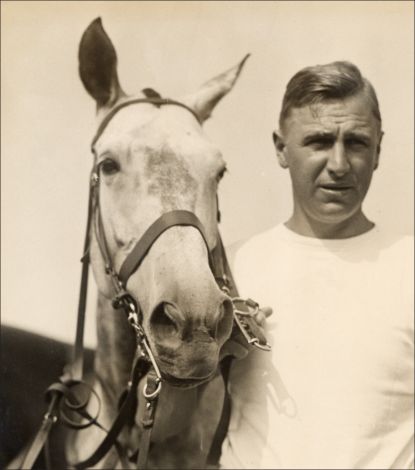
Tommy Hitchcock and Katrina
Watercolor portrait of Katrina (above left) by artist, Melinda Brewer; www.poloart.ca
-
Khaki2010
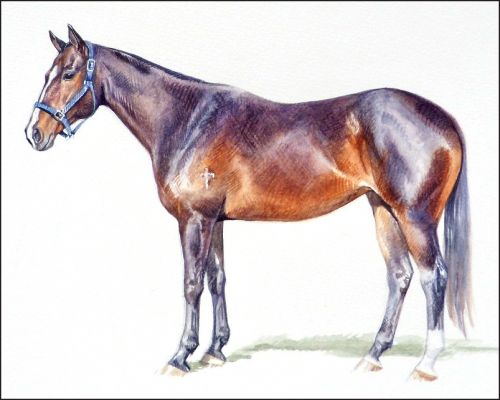 Inductee to Horses to Remember
Inductee to Horses to RememberKhaki
Elected 2010Although quiet around the barn, Hector Galindo’s gallant mare had it all on the field – heart, stamina, quick acceleration, sustained speed and incredible, overall athletic ability. And she played two chukkers per match for much of her career. Galindo said, “Every time she goes out there, she plays the game, she gives me as much as she has.”
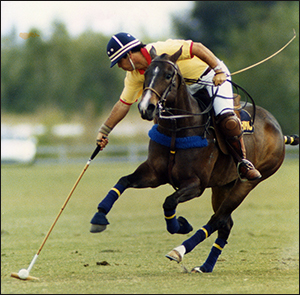 Khaki seemed to have an innate ability to read the game. “In one game a while back,” Galindo said, “the whole pack was going one way; the ball got turned around; she turned before I did and left me sitting on her neck. She read the play before I did.”
Khaki seemed to have an innate ability to read the game. “In one game a while back,” Galindo said, “the whole pack was going one way; the ball got turned around; she turned before I did and left me sitting on her neck. She read the play before I did.”Khaki won Best Playing Pony at the 1995 East Coast Open, the 1995 and 1998 Silver Cups, the 1997 Sterling Cup, the 2000 Gold Cup of the Americas, and the 2003 Iglehart Cup.
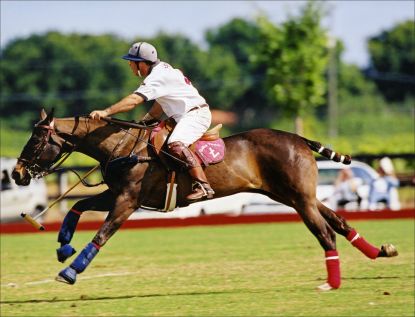
Watercolor portrait of Khaki (above left) by artist, Melinda Brewer; www.poloart.ca
-
La Fortuna2011
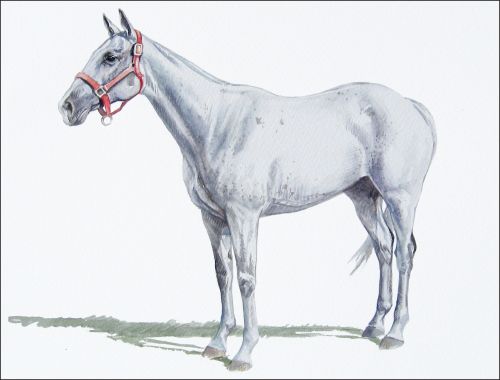 Inductee to Horses to Remember
Inductee to Horses to RememberLa Fortuna
Elected 2011A gray 15.1 hand Thoroughbred gelding, La Fortuna was one of Tommy Wayman’s favorite horses, named after the Argentine estancia (ranch) of Ricardo “Dickie” Santamarina where the horse was bred and raised. Wayman recalls, “He was very green, but he took to polo like a duck to water... He’s a very powerful horse, very strong, yet always relaxed and easy to ride.”
La Fortuna carried Wayman to victory in the U.S. Open and garnered many best playing pony awards in his long career. Wayman noted, “The only fault La Fortuna has is that I can’t get another one like him.”
While owned by Santamarina, La Fortuna raced in Palermo and Buenos Aires as “Lord Chico.” When Tommy Wayman bought the horse, he kept him in Argentina for a while, where even his young children could stick and ball with him because the horse was so quiet and good-natured. After La Fortuna came to the U.S., it took time for him to acclimate – the seasons are backwards, the feed is different, and Argentine horses need to adjust to the U.S. style of shoeing.
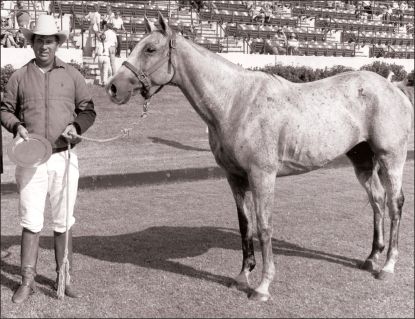
Tommy Wayman with La Fortuna, early 1980s
But from his first 18-goal polo match in California, La Fortuna just got better and better. Tommy Wayman said, “Probably his best quality is the way he will run through a bump. When somebody tries to knock him off the ball, they can hit him as hard as they like, but it doesn’t affect him. He just keeps on going... Everybody has got a horse that’s fast and handy but to have one that is strong, quick, and can bust through bumps and get you to the ball is unique.” La Fortuna became known throughout the U.S. as a very talented horse, and played polo until his retirement at age 14.
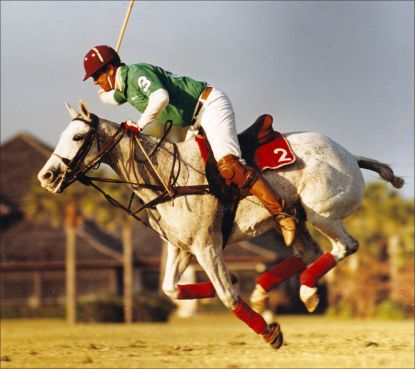
Tommy Wayman on La Fortuna, Palm Beach Polo Club
Watercolor portrait of La Fortuna (above left) by artist, Melinda Brewer; www.poloart.ca
-
Levicu2006
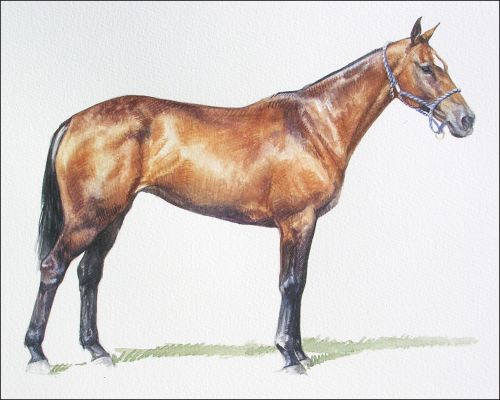 Inductee to Horses to Remember
Inductee to Horses to RememberLevicu
Elected 2006Levicu was a bay mare acclaimed for her fantastic acceleration, flat-out speed, and endurance, owned by Peter Brant and praised by many players. For many years a mainstay of the elite White Birch string, she helped the team to many high-goal victories. The awards during her stellar career were many, including Best Playing Pony of the Gold Cup in 1983, 1989 and 1990.
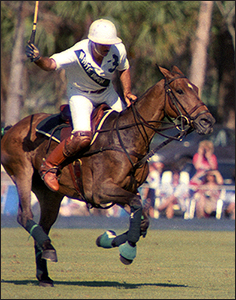 Described by one writer as a “butter-mouthed speed-and-shove specialist,” Levicu was bred by Hector Barrantes and made her reputation in Argentina, then as a star for White Birch in the U.S.A. Levicu’s exceptional heart and courage first became apparent when she played three chukkers in the final of a hard-fought Argentine Open, leading La Espadana to victory. She then continued her winning ways in the U.S. and was considered “the best horse in Florida for at least five years” according to Owen Rinehart.
Described by one writer as a “butter-mouthed speed-and-shove specialist,” Levicu was bred by Hector Barrantes and made her reputation in Argentina, then as a star for White Birch in the U.S.A. Levicu’s exceptional heart and courage first became apparent when she played three chukkers in the final of a hard-fought Argentine Open, leading La Espadana to victory. She then continued her winning ways in the U.S. and was considered “the best horse in Florida for at least five years” according to Owen Rinehart.In 1985, ridden by Gonzalo Pieres of the White Birch team, Levicu fought out three chukkers for the team’s victory in the Piaget World Cup. Pieres summed it up: “She had everything, including the proverbial big heart; she never gave up.”
Christian LaPrida said, “She is out of this planet, amazing. Everything you want in a pony. She makes you feel confident, makes you play.”
That sentiment was shared by opponents, who, in the words of one writer, “have seen Levicu make their horses look like carousel fixtures.”
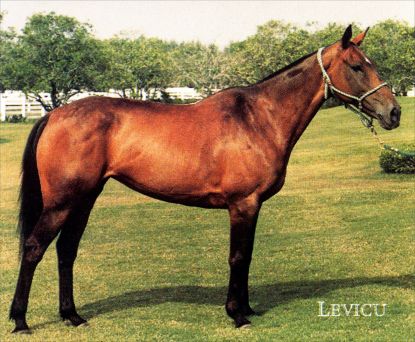
Watercolor portrait of Levicu (above left) by artist, Melinda Brewer; www.poloart.ca
-
Little Lou Dee2008
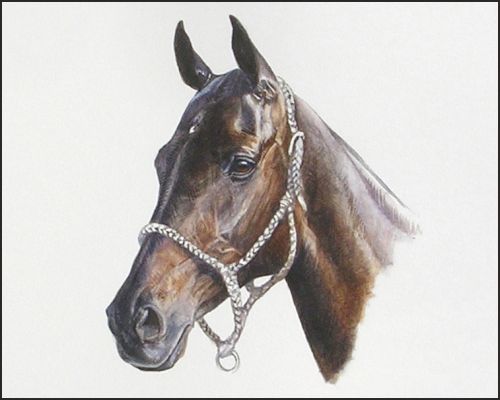 Inductee to Horses to Remember
Inductee to Horses to RememberLittle Lou Dee
Elected 2008Bred and owned by Tommy and Billy Wayman, this gallant little black mare played in eight U.S. Opens, the Cup of the Americas and the World Cup. She was named Best Playing Pony in the Intercircuit Cup and the Silver Cup, and won the Hartman Award at the U.S. Open in 1975. That same year, Little Lou Dee and Tommy also won the Butler Handicap, the Gold Cup and the Camacho Cup.
In 1982, a writer noted, “She’s won so many awards that both Billy and Tommy Wayman have lost track. Her mother, Big Lou Dee, won almost as many herself.”
At 15.1 hands, Little Lou Dee looked small. But she carried Billy Wayman for two seasons and Tommy for six. She had a good head, a nice short back, short pasterns and a good flat bone. Her talent was for going from a standing stop to a wide-open run. Little Lou Dee was also extremely bold, yet very, very easy. And because she took care of herself, she was never lame. Tommy stated, “She was just the perfect polo pony, always sound and always ready to play. She was one of those exceptional horses, 1 in 10,000 that come along once in a lifetime.”
“A little mare,” Billy Wayman added, “with a great big heart.”
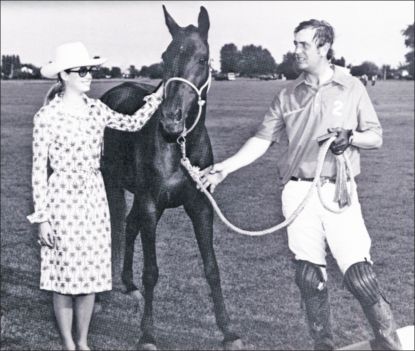
Watercolor portrait of Little Lou Dee (above left) by artist, Melinda Brewer; www.poloart.ca
-
Little Mary2021
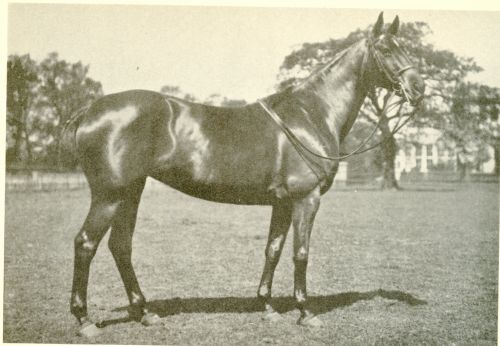 Inductee to Horses to Remember
Inductee to Horses to RememberLittle Mary
Elected 2021Little Mary – bred in Ireland, the much-celebrated bay pony “Little Mary” was owned by August Belmont and loaned to the American team, played by Larry Waterbury as part of The Big Four of 1909, winners of the International matches against Great Britain. Shortly after her return from England in 1909, she was injured and thought to be permanently retired. But she recovered and was called upon as part of the American team again, winning the Internationals of 1911 and 1913.
A grand looking pony, there was certainly nothing diminutive about “Little Mary” – she was a good-sized mare, standing well over 15 hands and up to any weight. Played prior to any known awards being established, she was cited by experts of her era as among the trinity of the three greatest polo ponies of that time. She was immortalized in the famed Haseltine bronze “The Big Four” that depicts Larry Waterbury on Little Mary along with the other team members and their legendary mounts. The image of this sculpture is used as the emblem for the Museum of Polo and Hall of Fame.
-
Lovely Sage2018
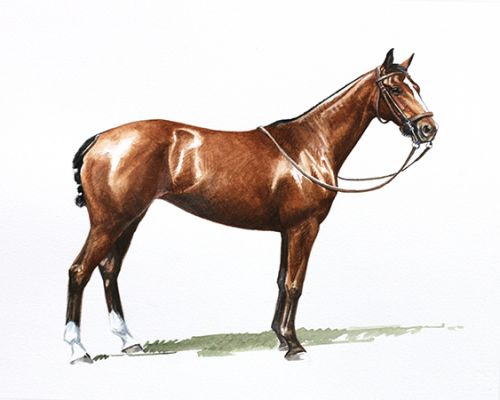 Inductee to Horses to Remember
Inductee to Horses to RememberLovely Sage
Elected 2018As beautiful as her name would imply, the attributes of Lovely Sage did not stop at that. She possessed a rare combination of speed, dexterity and wonderful disposition. Lovely Sage made history as the first winner of the Willis Hartman Award to recognize the Best Playing Pony of the U.S. Open Tournament established in 1965 when it was given to the best horse throughout the entire tournament, not just playing in the final.
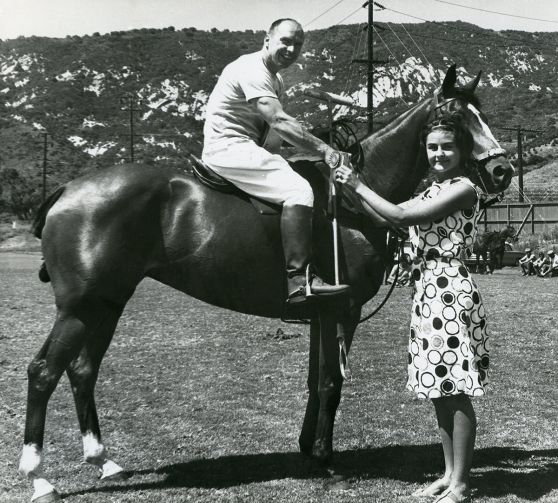
Dr. Linfoot with Lovely Sage, winner of the Polo Pony Performance class, and presenter, Carol Oxley
A papered Thoroughbred mare foaled in 1957 (by Barval out of Parsage), one can only speculate on how she made her way into a backyard in Modesto, California where she was found by Fay Humphries, a polo playing cowboy with a true horseman’s eye for good ponies. From there she went on to Hall of Famer Dr. William “Billy” Linfoot who sold her to Ruddy Tongg, a Hawaiian businessman and polo player. Tongg was also the owner of the Santa Barbara Polo Club. Linfoot played her as part of the Santa Barbara team and regarded her as his best pony in the ’65 Open when she won the inaugural Hartman Award. When Ruddy had a polo accident that ended his playing days, he sold his horses, and Lovely Sage was purchased by Hap Sharp. The mare was part of the string he sent to Argentina to represent the U.S. in the Cup of the Americas in 1969. Sharp’s son-in-law, famed horseman and Hall of Famer Tommy Wayman, had played Lovely Sage and later used her for his breeding program.
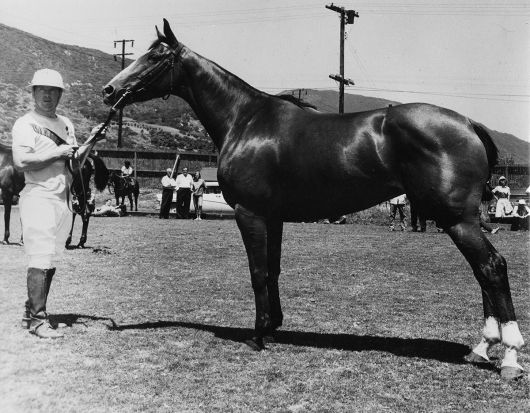
Lovely Sage, winner of the light-heavy weight Polo Pony class,
1963 U.S. Open, with Dr. Linfoot
Watercolor portrait of Lovely Sage (above left) by artist, Melinda Brewer; www.poloart.ca
-
Magazin2004
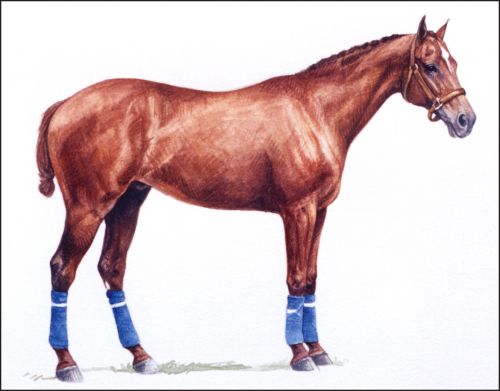 Inductee to Horses to Remember
Inductee to Horses to RememberMagazin
Elected 2004Originally known as Magasin, this liver chestnut stallion was owned and played by Delmar Carroll for 13 years, and won the Hartman Trophy at the U.S. Open in 1972. Sired in Argentina, Magazin was bred for thoroughbred racing rather than polo. In fact, Michael Phipps bought and raced Magazin until the age of 5. But when Del Carroll showed an interest in the horse, Phipps proposed an unusual challenge: Carroll could have Magazin if he could make a polo pony out of him. Magazin took to polo like a duck to water, and the rest is polo history.
“Del gave 110 percent on the field, and his horses had to give 150 percent,” remembers Tommy Wayman. “Magazin gave his best effort every time.”
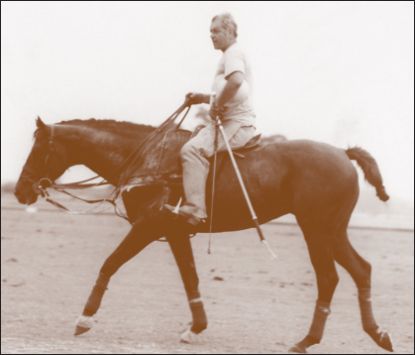
Magazin was born with great conformation, possessed a natural ability to play polo, was quiet and even-tempered. “He did everything well,” noted Kathy Linfoot, Magazin’s first trainer. “Speed, durability – he could go through two chukkers easily and be ready for more. Magazin was such a natural all I had to do was stay out of his way.”
Magazin made an impression off the field as well. “Everyone knew him. He was ‘Mr. Personality’. If you rubbed his face he would stick his tongue out. Every morning he would whinny until I fed him.”
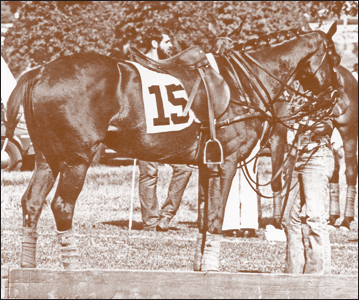
Magazin’s disposition was remarkable not only for a stallion, but for any horse. Robin Carroll Bostwick recalls, “At Christmas time, when Mags was turned out at my dad’s farm, I would get him straight out of the pasture and ride him bareback through fields and by the mares, without a problem; he was such a one-of-a-kind angel.”
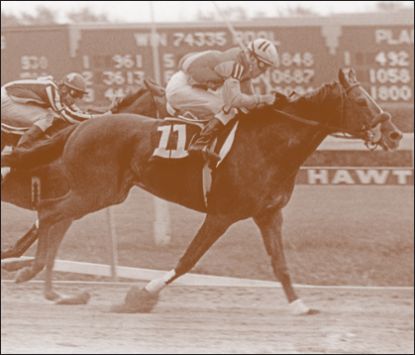
Watercolor portrait of Magazin (above left) by artist, Melinda Brewer; www.poloart.ca
-
Mr. Polo2019
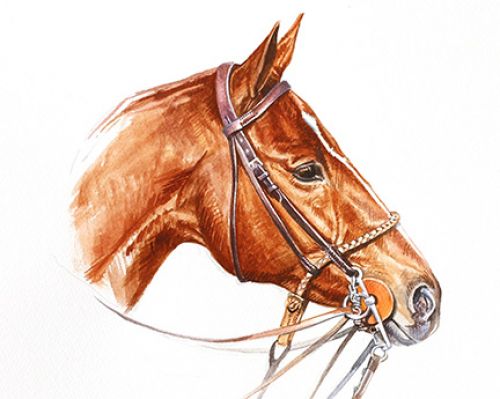 Inductee to Horses to Remember
Inductee to Horses to RememberMr. Polo
Elected 2019Memo Gracida’s memorable old war horse, Mr. Polo, more than lived up to his name. Playing in his first U.S. Open at age 4, the magnificent chestnut thoroughbred gelding played with heart for Memo through over 10 years of high goal polo winning eight U.S. Opens, always playing two chukkers. He earned many Best Playing Pony awards in other major tournaments along the way and was featured in Sports Illustrated magazine.
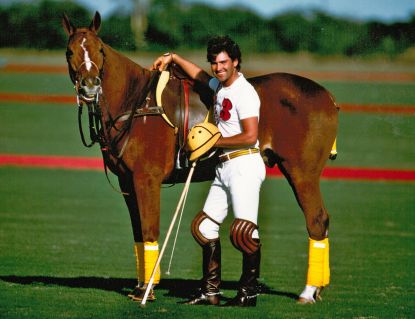
Mr. Polo with Memo Gracida in 1985; Photo by Red Morgan
Mr. Polo was a perfect example of the extraordinary talent that can be found in thoroughbred horses bought from the race track and re-purposed for polo. Bred in New Mexico, he was purchased by Hall of Famer Memo Gracida the day after winning a race at Sunland Park and went on to polo greatness. Mimi Gracida Boyle related “Mr. Polo had an amazing career from the time he was 3 until his retirement at 14. He won countless Best Playing Pony awards including the Camacho Cup when he was only 4. He played two chukkers in every game he started. He was instrumental in the victories of six different U.S. Open Championships, World Cups, Silver and Gold Cups and many other tournaments. Luckily, a successful DNA removal was performed a few years ago and, hopefully a Mr. Polo Jr. will be playing in the future.”
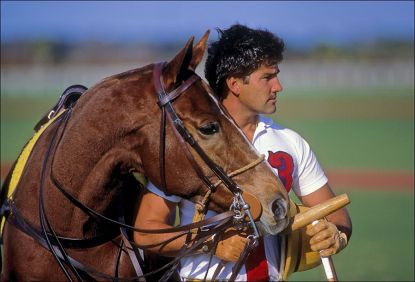
Mr. Polo with Memo Gracida in 1985; Photo by Red Morgan
Mr. Polo died on June 1, 2015 at the age of 38 and will be forever remembered as one of the great equine athletes in the sport of polo.
Watercolor portrait of Mr. Polo (above left) by artist, Melinda Brewer; www.poloart.ca
-
Nebraska Sunset2017
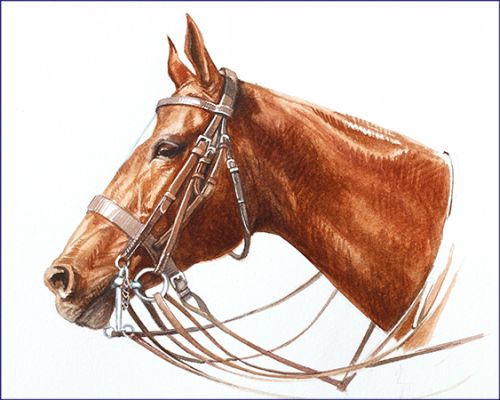 Inductee to Horses to Remember
Inductee to Horses to RememberNebraska Sunset
Elected 2017Inducted in 2017, Charles Smith’s great, multi-award winning mare, Nebraska Sunset, was purchased as a 3-year-old from the Norman family in Crawford, Nebraska, and trained by Charles’ father, the great Hall of Famer and renowned horseman, Cecil Smith. The 15.2 chestnut thoroughbred mare (by Rule the West Wind x Omaha’s Princess) was played by Charles for the next decade.
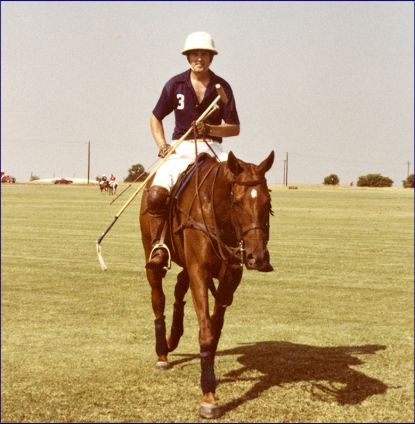
Charles Smith on Nebraska Sunset
Dependable as she was, she never failed him. As a crowning achievement in her notable career, she was the 1980 winner of the Hartman Award for Best Playing Pony of the U.S. Open. Charles also played the mare two periods in the 1979 and 1980 Cup of the Americas games. He noted, “Nebraska Sunset was probably the best all-around horse I ever owned. She had the best combination of speed and agility, very easy and anyone could play her from a beginner to a pro… I can gamble on her, take chances, because she can always get me back into a play.” Nebraska Sunset is remembered by many other great Hall of Famers and horsemen, like Tommy Wayman, as one of the top-notch ponies of her time.
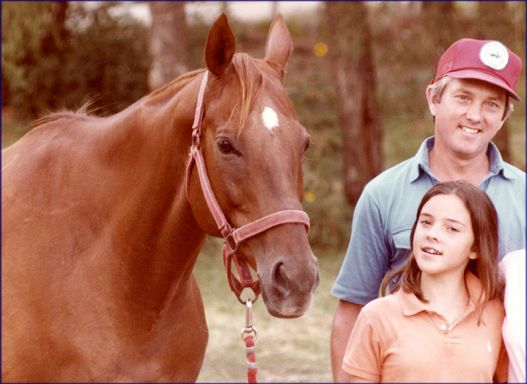
Nebraska Sunset with Charles Smith and his daughter, Jennifer
Watercolor portrait of Nebraska Sunset (above left) by artist, Melinda Brewer; www.poloart.ca
-
Ragamuffin2002
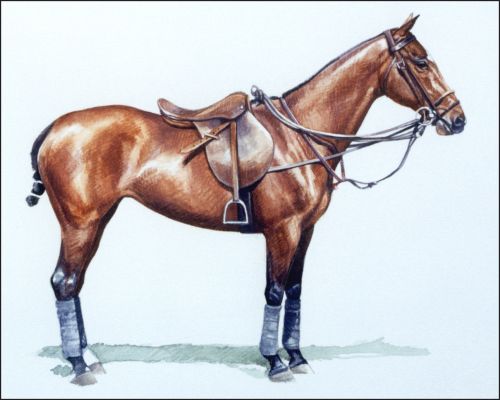 Inductee to Horses to Remember
Inductee to Horses to RememberRagamuffin
Elected 2002Bred by John T. Oxley in Oklahoma, this bay mare was later owned and played by Northrup R. Knox. Ragamuffin was the winner of the Willis L. Hartman Trophy for Best Playing Pony in the U.S. Open in 1968. The following year in Argentina, she won acclaim from Argentines as well when she played in both the Cup of the Americas and in the Argentine Open.
In three games of the 1966 and 1969 Cup of the Americas tournaments, Ragamuffin played a total of eight chukkers, a tribute to her brilliance, stamina and longevity at the highest level of international high-goal polo. At the Argentine Open, she was awarded the Lady Susan Townley Cup for Best Playing Pony, and is the only pony in history to win both the Hartman and Townley awards.
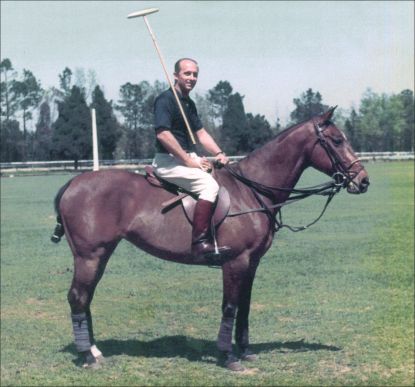
Norty Knox on Ragamuffin
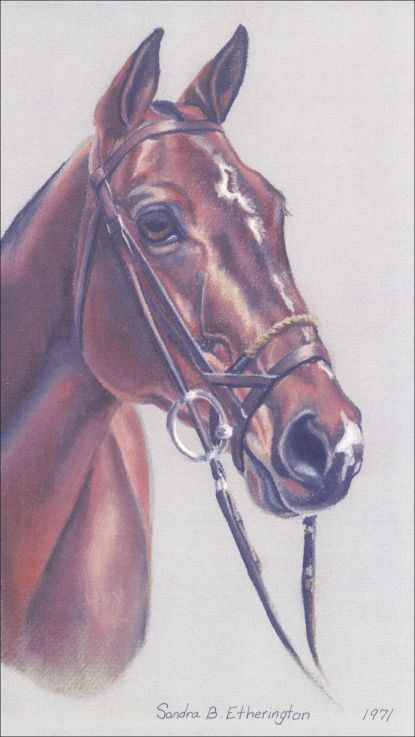
Watercolor portrait of Ragamuffin (above left) by artist, Melinda Brewer; www.poloart.ca
-
Red Ace2010
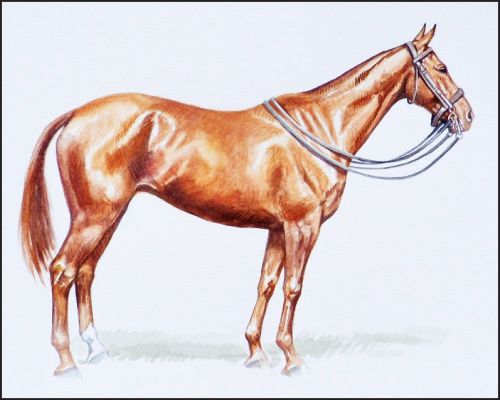 Inductee to Horses to Remember
Inductee to Horses to RememberRed Ace
Elected 2010Dr. E.J. Boeseke, Sr., found Red Ace at a Tijuana racetrack, brought him to California and trained him as a polo pony. In the East West match of 1933, with E.J. Boeseke, Jr., in the saddle, Red Ace won Best Playing Pony. But he is best remembered for a moment in the game when he won hearts as well. After Boeseke was knocked to the ground in a particularly rough play, Red Ace turned, trotted back, stood by his unconscious master and gently nuzzled him.
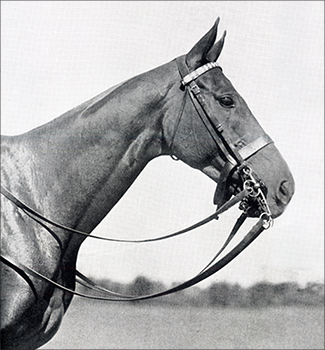 Prior to his memorable performances in the East West series, Red Ace played polo on both coasts in the U.S., in South America with a North American team, and in England. He was remembered by Seymour Knox as a “brilliant pony,” and by Thomas C. Nelson of Argentina as one of the best ponies he’d ever had anything to do with. He had great straightaway speed and great courage.
Prior to his memorable performances in the East West series, Red Ace played polo on both coasts in the U.S., in South America with a North American team, and in England. He was remembered by Seymour Knox as a “brilliant pony,” and by Thomas C. Nelson of Argentina as one of the best ponies he’d ever had anything to do with. He had great straightaway speed and great courage.Red Ace routinely played two chukkers in a game, and Elmer Boeseke was one of the biggest and most hard-riding men in polo. In a 1934 article in the New York Herald Tribune, the writer noted, “When up on Red Ace, Boeseke’s game was of a higher standard. He seemed surer. He knew he could trust Red Ace.”
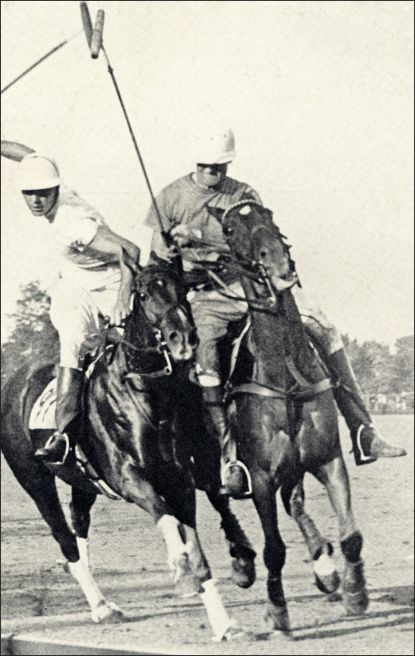
Elmer Boeseke on Red Ace (right), 1934 East-West Series
Watercolor portrait of Red Ace (above left) by artist, Melinda Brewer; www.poloart.ca
-
Rotallen2009
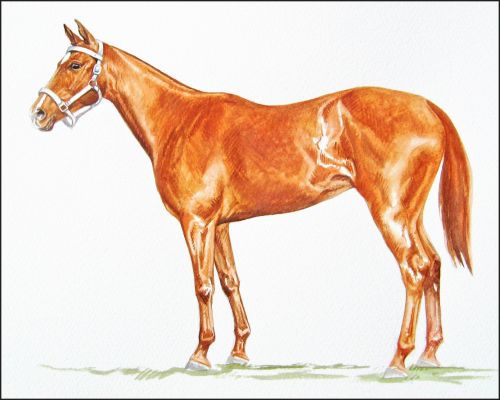 Inductee to Horses to Remember
Inductee to Horses to RememberRotallen
Elected 2009Northrup Knox’s Rotallen was one of his legendary group of mares known as the “4 Rs” and with them Knox was generally recognized as the best mounted man in polo. In Argentina, with her stable-mate Ragamuffin, Rotallen played eight periods during the Cup of the Americas in both 1966 and 1969. She emerged from those contests famed for her heart, tenacity and extraordinary level of play.
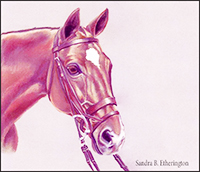 Rotallen was foaled in Rio Medina, Texas, bred by Albert Beck. As a two-year-old, she won a race in New Orleans and caught the eye of Cecil Smith who bought her and trained her for polo. Rotallen played gamely in the major tournaments of 1964 and 1965, including the 20 Goal; she was played in the U.S. Open at Oakbrook by Cecil’s son, Charles Smith. Before the U.S. Open in Santa Barbara in 1966, Rotallen was tried by Lewis Smith who was then playing for Northrup R. Knox. Smith called Knox and urged her purchase, and the pony won the Hartman Award two weeks later as part of Norty Knox’s outstanding string. She played in the Cup of the Americas in 1966 and 1969, and in 1969 she won Best Playing Pony of the National 16-Goal. The lovely Rotallen joins her equally talented stable-mate, Ragamuffin, who was inducted into the Hall of Fame previously.
Rotallen was foaled in Rio Medina, Texas, bred by Albert Beck. As a two-year-old, she won a race in New Orleans and caught the eye of Cecil Smith who bought her and trained her for polo. Rotallen played gamely in the major tournaments of 1964 and 1965, including the 20 Goal; she was played in the U.S. Open at Oakbrook by Cecil’s son, Charles Smith. Before the U.S. Open in Santa Barbara in 1966, Rotallen was tried by Lewis Smith who was then playing for Northrup R. Knox. Smith called Knox and urged her purchase, and the pony won the Hartman Award two weeks later as part of Norty Knox’s outstanding string. She played in the Cup of the Americas in 1966 and 1969, and in 1969 she won Best Playing Pony of the National 16-Goal. The lovely Rotallen joins her equally talented stable-mate, Ragamuffin, who was inducted into the Hall of Fame previously.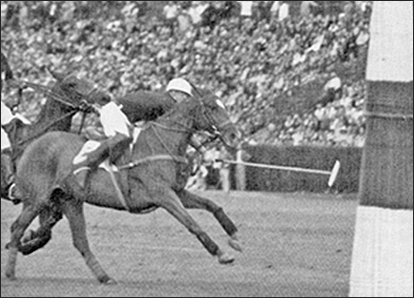
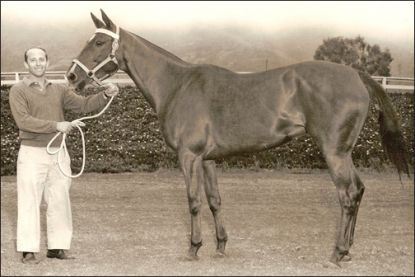 Norty Knox and Rotallen
Norty Knox and RotallenWatercolor portrait of Rotallen (above left) by artist, Melinda Brewer; www.poloart.ca
-
Ruifino2018
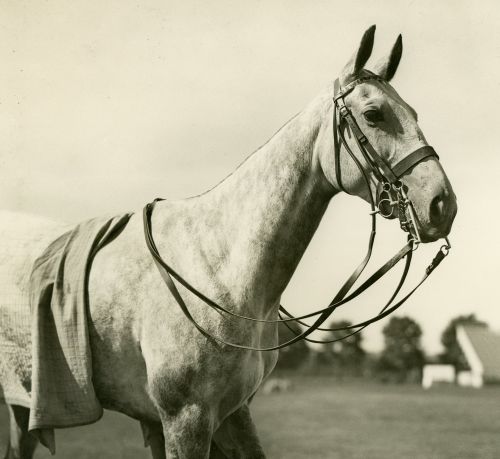 Inductee to Horses to Remember
Inductee to Horses to RememberRuifino
Elected 2018Her story began in Argentina where she was a favored mount of the hard-riding Manuel Andrada. As Fred Post told it, in 1934 he sent an agent (Wiley Jones) back to Argentina to buy her after having seen her play the year prior and apparently regretted not having bought her then. Renowned horseman J.C. Cooley asked for first crack at her upon her arrival in the states as a potential mount for Jock Whitney. Whitney played her one period and “that settled it.” For the next six years, she played as part of his string of stars.
Her courage and ability was exemplified by her play in the 1935 Monty Waterbury Cup that may be summed up best by an excerpt from POLO, Nov. 1935: “No one who witnessed it can ever forget the picture of the gray mare and Tommy Hitchcock in the sixth chukker, when Greentree from being three goals behind came up on even terms with Templeton. It was one of the supreme chukkers of polo, easily the highlight of the year, and the engraved record of what happened will be, as long as this cup exists, mute testimony to a gallant animal giving of her very best in the hands of a supreme performer.
-
Sue Ellen2015
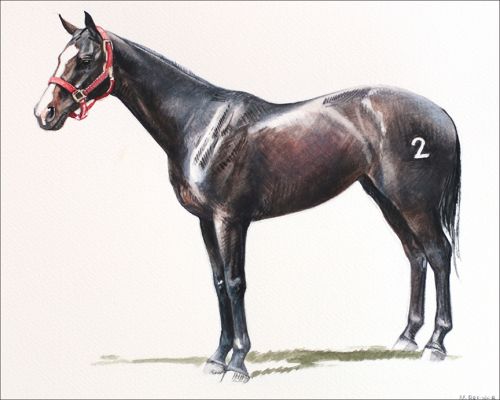 Inductee to Horses to Remember
Inductee to Horses to RememberSue Ellen
Elected 2015From her birth in 1990, the dark bay Thoroughbred mare Sue Ellen was destined for greatness. She was bred, raised and trained by horseman and Hall of Famer Tommy Wayman, and her dam was the great Little Lou De, a mare honored in the Hall of Fame in 2008. Possessing great power and speed, but also handy, quiet and relaxed, Sue Ellen played with finesse.
“If a horse’s worth is accounted by the total goals of players who have ridden her, Sue Ellen may be just about the best horse ever to play polo,” said Tommy Wayman, referring to the nine 10-goal players who have chosen to play her.
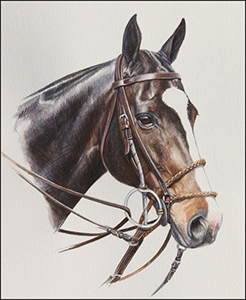 When Sue Ellen was a four-year-old, her ownership passed to John Goodman, patron of the Isla Carroll team. And Wayman adds, “She probably contributed more to the Isla Carroll success than any other horse over there.”
When Sue Ellen was a four-year-old, her ownership passed to John Goodman, patron of the Isla Carroll team. And Wayman adds, “She probably contributed more to the Isla Carroll success than any other horse over there.”In 2001, she was sold to Mariano Aguerre, and next to Black Watch patron Neil Hirsch, whose team member Gonzalo Pieres, Jr., played her in the 2006 U.S. Open.
A former 7-goaler and breeder of polo ponies, Joey Casey, said of Sue Ellen, “She does everything with ease. She is good enough to get along with almost anyone, and many good players have played her. Sue Ellen is similar to another great horse from years ago, owned by the late John Oxley, called Cat-A-Joy… they both have that great, calm disposition and an exceptional mind… They never waste energy on nervousness, so they always have energy left to play a second chukker. That is what separates the good horses from the great horses.”
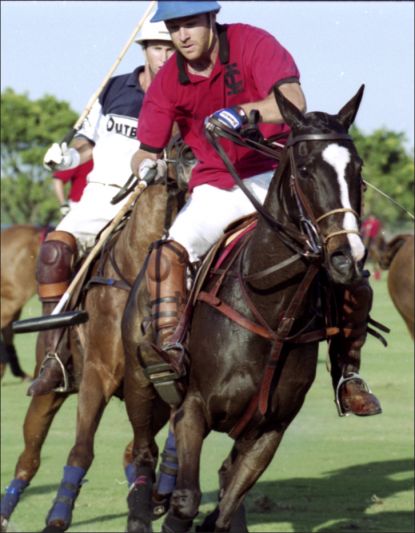
Now retired, Sue Ellen is grazing happily in Argentina, owned by Nacho Figueras and producing foals which he hopes will be of equal greatness. In 2014, he said, “I have a big breeding operation here in Argentina: Right now I have more than 500 horses. I have different favorites for different reasons, but if I had to name one I would say the most special horse is Sue Ellen. She is a mare that was bred by one of the best American players in the history of our sport, Tommy Wayman. Her mother was the best playing pony in the U.S. Open, her grandmother was the best playing pony in the U.S. Open, and she was the best playing pony at the Queen’s Cup in England and the Gold Cup in America. She has been breeding for five or six years now.”
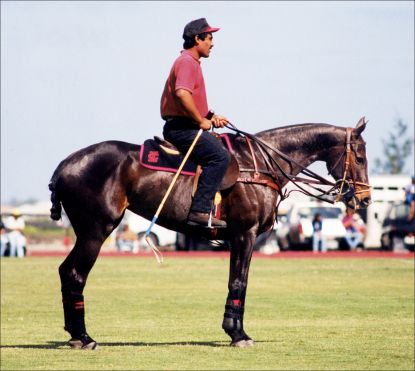
Watercolor portrait of Sue Ellen (above left) by artist, Melinda Brewer; www.poloart.ca
-
Sweet William2002
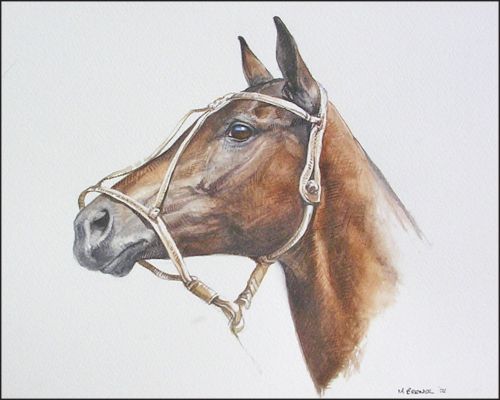 Inductee to Horses to Remember
Inductee to Horses to RememberSweet William
Elected 2002Sweet William, a brown thoroughbred gelding, earned worldwide acclaim by winning Best Playing Pony awards in the U.S.A., Great Britain and Spain. Owned and ridden by 10-goal great Tommy Wayman, the pony was “just the greatest animal athlete ever.” Purchased in 1973 for $500 from a ranch in South Dakota, Sweet William was playing polo within a month.
“He was a natural”, Wayman said. “There wasn’t any other horse that could outrun him, there wasn’t any other horse that could out-handle him.”
In Great Britain, Sweet William was the best playing pony in all the Coronation Cups that Wayman played in, and in Spain, he was the best playing pony in three King’s Cups. In 1985, Wayman spoke at length about his horse for Polo magazine:
“Sweet William turned out to be the perfect polo pony. He had excellent conformation and was very fast. But it was his attitude that made him rise to the top. He had the kind of mentality you can’t train into a horse. It’s either there or it isn’t. He never got nervous or overly excited. He could give me speed I needed without the anxious edge you often get with Thoroughbred quickness.
“The horse seemed to thrive on the cheering crowds and excitement of the game. In fact, he was quite a ham. He would actually pose for the camera and he did get a lot of media attention. In Europe, the press would call me before a big match to ask how Sweet William was and what chukker I would play him. People from as far away as Australia would stop by to have their pictures taken with him.
“On the field, he was my secret weapon. If I asked for the impossible play, he gave it to me. When my team was behind going into the final chukker, I’d play him. If I needed four goals to win the game, we’d do it; if five were required, five we’d make. I once scored six goals in one chukker on Sweet William.
“No matter how tough the play, he would remain completely controllable. In a race with another horse, he would rate right on the money. I’d just set his speed, drop the reins and sit back; he’d hold himself at the exact pace I’d put him. Playing the game was physically easy for him, so a fairly loose rein would get a very precise performance. Add to that his apparent enjoyment of the sport and you have the ideal mount, which he was.”
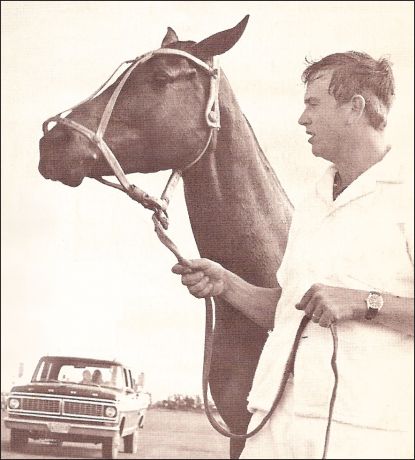
Sweet William with Tommy Wayman
Watercolor portrait of Sweet William (above left) by artist, Melinda Brewer; www.poloart.ca
-
Tenby2011
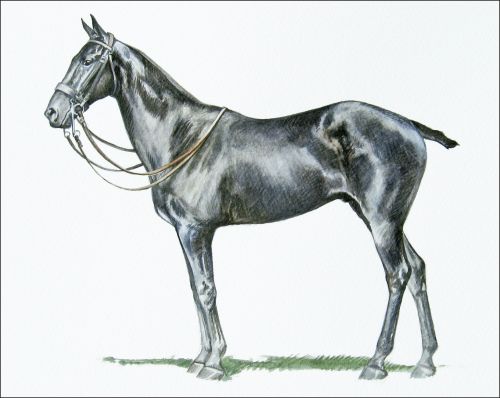 Inductee to Horses to Remember
Inductee to Horses to RememberTenby
Elected 2011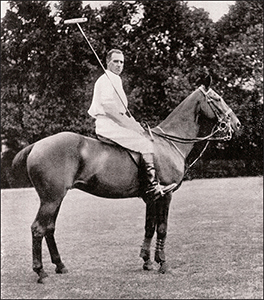 Foaled in 1903, Tenby was the gallant black gelding who carried Devereux Milburn Sr. for three periods in each of the Westchester Cup matches of 1913, 1914 and 1921, a tribute to the horse’s talent and endurance. As one writer observed in 1927, “There never lived an honester and gamer pony.”
Foaled in 1903, Tenby was the gallant black gelding who carried Devereux Milburn Sr. for three periods in each of the Westchester Cup matches of 1913, 1914 and 1921, a tribute to the horse’s talent and endurance. As one writer observed in 1927, “There never lived an honester and gamer pony.”Tenby, originally owned by William Balding, was one in a string of six ponies that Harry Payne Whitney gave to Devereux Milburn as a wedding present. The English-bred pony, three-quarters thoroughbred, became Milburn’s favorite and the hero of hundreds of hard-fought matches, a handsome sable flash who always seemed to have a shade more speed than any horse trying to catch him.
But according to Frank Milburn, Devereux Milburn Sr.’s grandson, Tenby was not without a fault: “Tenby had a problem - he wouldn’t stop. Sometimes Milburn stopped, but the horse didn’t. He once fell off Tenby three times in a period.”
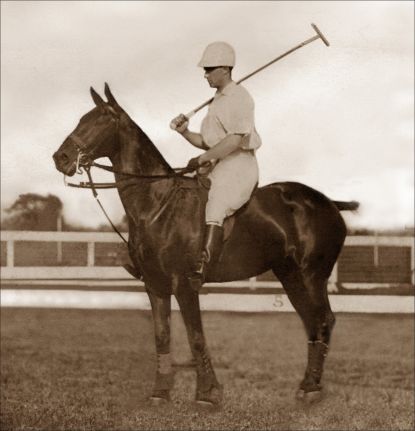
On the return voyage to the States after the 1921 Westchester Cup tournament, Tenby passed away at 18 years of age. He was given a full shipboard funeral. Polo Monthly in 1921 noted, “Tenby will long be affectionately remembered as one of the best polo ponies of his age.” Tenby and Milburn are also remembered in a portrait painted by American sporting artist Franklin Brooke Voss, now in the collection of the Museum of Polo.
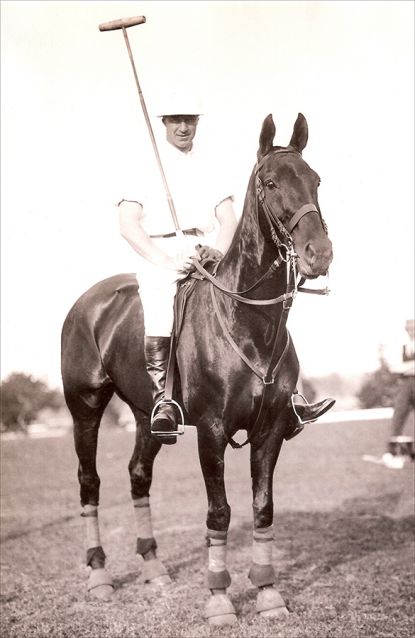
Devereux Milburn and Tenby
Watercolor portrait of Tenby (above left) by artist, Melinda Brewer; www.poloart.ca
-
Tobiana2000
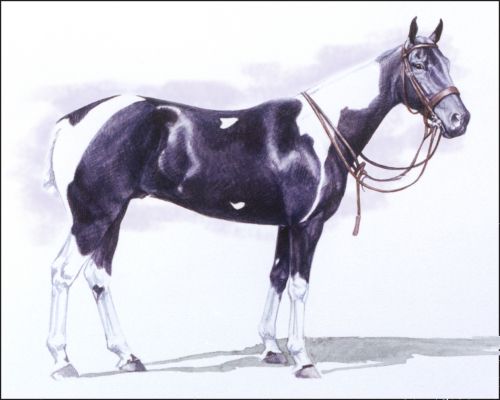 Inductee to Horses to Remember
Inductee to Horses to RememberTobiana
Elected 2000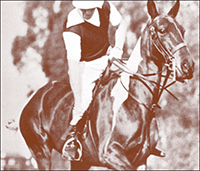 Tobiana was a celebrated Argentine-bred piebald (black & white pinto) gelding, owned and played by the great 10-goaler, Tommy Hitchcock, Jr. In 1926, another legendary 10-goaler, Lewis Lacey, selected Tobiana for Hitchcock, finding him at a race track in Argentina. Lacey bought him, schooled him, and sent him north. The piebald pony had power and extreme speed, and was played by Hitchcock in many national and international matches, becoming one of the best known ponies of the era.
Tobiana was a celebrated Argentine-bred piebald (black & white pinto) gelding, owned and played by the great 10-goaler, Tommy Hitchcock, Jr. In 1926, another legendary 10-goaler, Lewis Lacey, selected Tobiana for Hitchcock, finding him at a race track in Argentina. Lacey bought him, schooled him, and sent him north. The piebald pony had power and extreme speed, and was played by Hitchcock in many national and international matches, becoming one of the best known ponies of the era.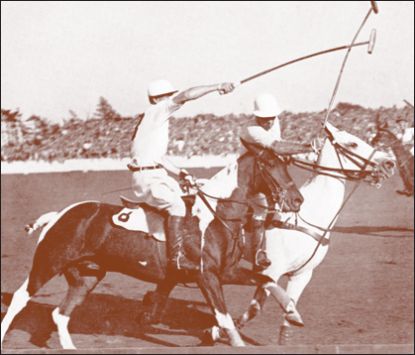
This quote from Polo magazine, in 1927, describes him beautifully:
“The picturesque Tobiana, who looked as if he had been painted by an enthusiastic artist armed with a broad brush, enchanted the onlookers by his appearance and he electrified them with his performance. And it is altogether fitting that the most sensational-looking animal on the grounds should have been ridden by the most sensational player. Where the Argentine piebald fled, the eyes of the multitude followed, and that was not surprising because Mr. Hitchcock’s position at Two, and his type of play, forever keep him in the attack... Tobiana played two chukkers in the first match and two in the second, and when he left the field, his brows figuratively wreathed with laurel, every child sighed, and we all were children.”
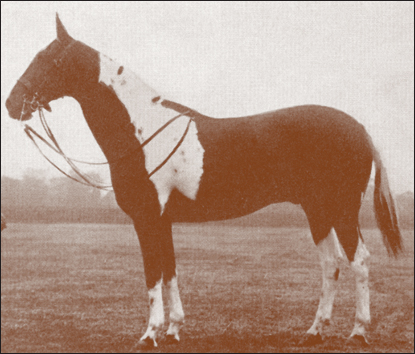
Watercolor portrait of Tobiana (above left) by artist, Melinda Brewer; www.poloart.ca
-
Toy Moon2016
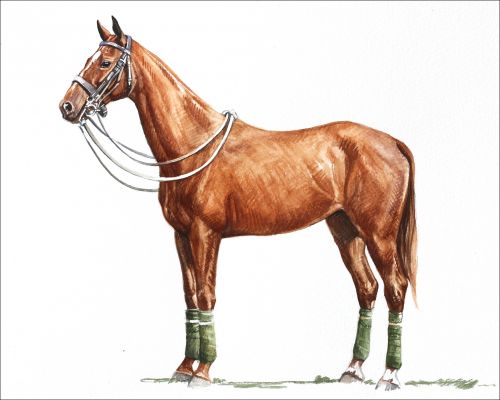 Inductee to Horses to Remember
Inductee to Horses to RememberToy Moon
Elected 2016The remarkably talented mare Toy Moon was bred in Hawaii circa 1931 by noted breeder of polo ponies, Walter Dillingham. Purchased from Dillingham in 1938, the fleet chestnut mare was brought to the mainland by Hall of Famer Elbridge T. Gerry, Captain of the Aknusti team, to be part of his illustrious string of ponies.
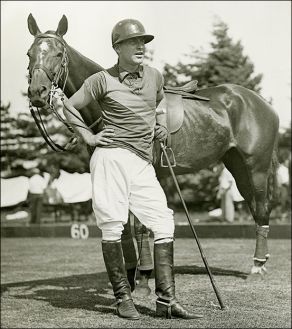 Toy Moon’s level of play set her apart as evidenced by her back-to-back wins, in 1940 and ’41, of the Prince Friarstown Challenge Cup, a coveted prize awarded to the best playing mare suitable to produce polo ponies; the judges based their decisions on her play in both the U.S. Open and Monty Waterbury cups. For this, and her long career of excellent and exceptional performances in which she was described as playing “top flight polo,” she was recognized by the experts as one of the great polo ponies of her era.
Toy Moon’s level of play set her apart as evidenced by her back-to-back wins, in 1940 and ’41, of the Prince Friarstown Challenge Cup, a coveted prize awarded to the best playing mare suitable to produce polo ponies; the judges based their decisions on her play in both the U.S. Open and Monty Waterbury cups. For this, and her long career of excellent and exceptional performances in which she was described as playing “top flight polo,” she was recognized by the experts as one of the great polo ponies of her era.After her playing days were over, Toy Moon lived out her life happily, to a ripe old age, at Gerry’s farm. As a broodmare, she produced two foals by a Standardbred stallion, and served as a steady and dependable mount taking great care with the Gerry children, who took her on many leisurely jaunts around the sprawling premises.
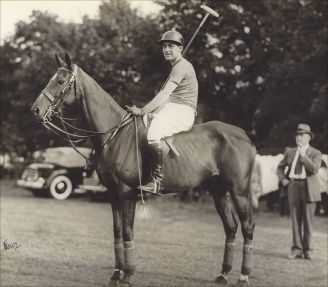 Toy Moon with Elbridge Gerry (right and above)
Toy Moon with Elbridge Gerry (right and above)Watercolor portrait of Toy Moon (above left) by artist, Melinda Brewer; www.poloart.ca
-
Wembley2020
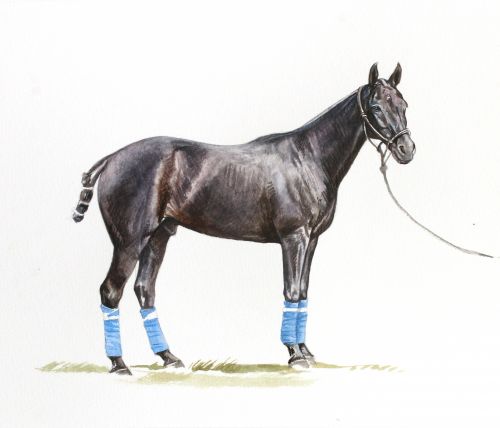 Inductee to Horses to Remember
Inductee to Horses to RememberWembley
Elected 2020A venerable veteran of the most highly competitive polo in the U.S. and around the world, Wembley has been played by the best players in the sport. Now owned by Robert P. Jornayvaz, III, the elegant black gelding was played by Bob’s Valiente team the last several seasons of his storied career.
Foaled in 1993 and playing until the age of 23, Wembley has been a recognizable hero on the polo field for many years. He was first owned and played by Hall of Famer Memo Gracida who discovered Wembley in England in 1999. Memo has said he knew the horse was special in the first 50 yards he rode him. Since then, Wembley has been around the world playing at the highest level by many of the best players in the sport and the accolades have abounded.
Counted among his laurels were numerous Best Playing Pony Awards, Horse of the Year in 2004, and in 2013 Wembley was the first recipient of the Wembley award established in his honor to recognize horses that have had longevity and excellence playing at the high goal level at IPC. That year, he played throughout the season and in four of six chukkers of the U.S. Open.
Wembley was retired in 2016 and is currently enjoying a well-deserved life of ease. Having been cloned, the world waits to see if the grand talent of Wembley will live on.
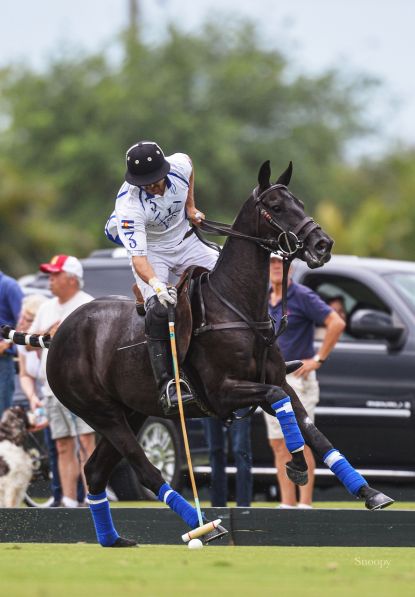
Wembley, Valiente string. Photo by Snoopy
-
Woodie D (aka Stormy)2001
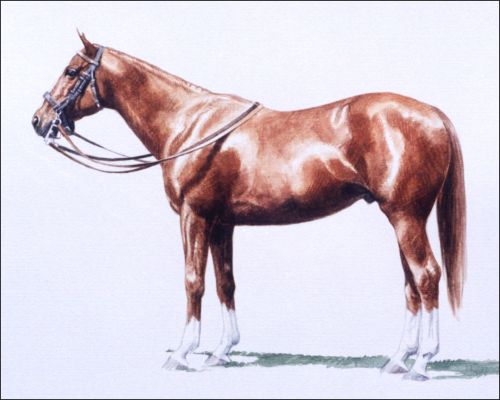 Inductee to Horses to Remember
Inductee to Horses to RememberWoodie D (aka Stormy)
Elected 2001Woodie D was a gem of a polo pony with many facets. The stallion was trained for polo by Carl Crawford in Texas; he was then owned by Bob Skene and later by John T. Oxley. In 1954, he added “actor” to his accomplishments, playing the part of “Stormy” in the Disney film Stormy the Thoroughbred, a movie about a race horse who finds his true calling as a polo pony.
Woodie D was unique in that he was a registered Quarter Horse and a registered Thoroughbred. This came about before his polo career, as he had sired three offspring that qualified (by type) for permanent registry as Quarter Horses. The Quarter Horse Stud Book had not yet closed and he was awarded papers.
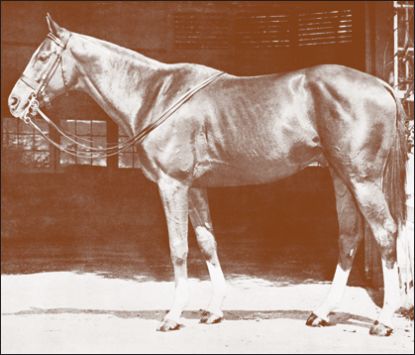
John T. Oxley obtained Woodie D after seeing him in the U.S. Open Championship in Chicago. “I bought him when he was 16 and played on him until he was 20. Then we stood him at the ranch until he was 27,” Oxley recalls.
Bob Skene said, “His agility and quickness, and his tremendous speed for short distances from a standing start or on a long run, were brilliant.” In 1970, Skene wrote, “If there were a polo pony hall of fame, the name of Woodie D or Stormy would be there.”
Watercolor portrait of Woodie D (above left) by artist, Melinda Brewer; www.poloart.ca

